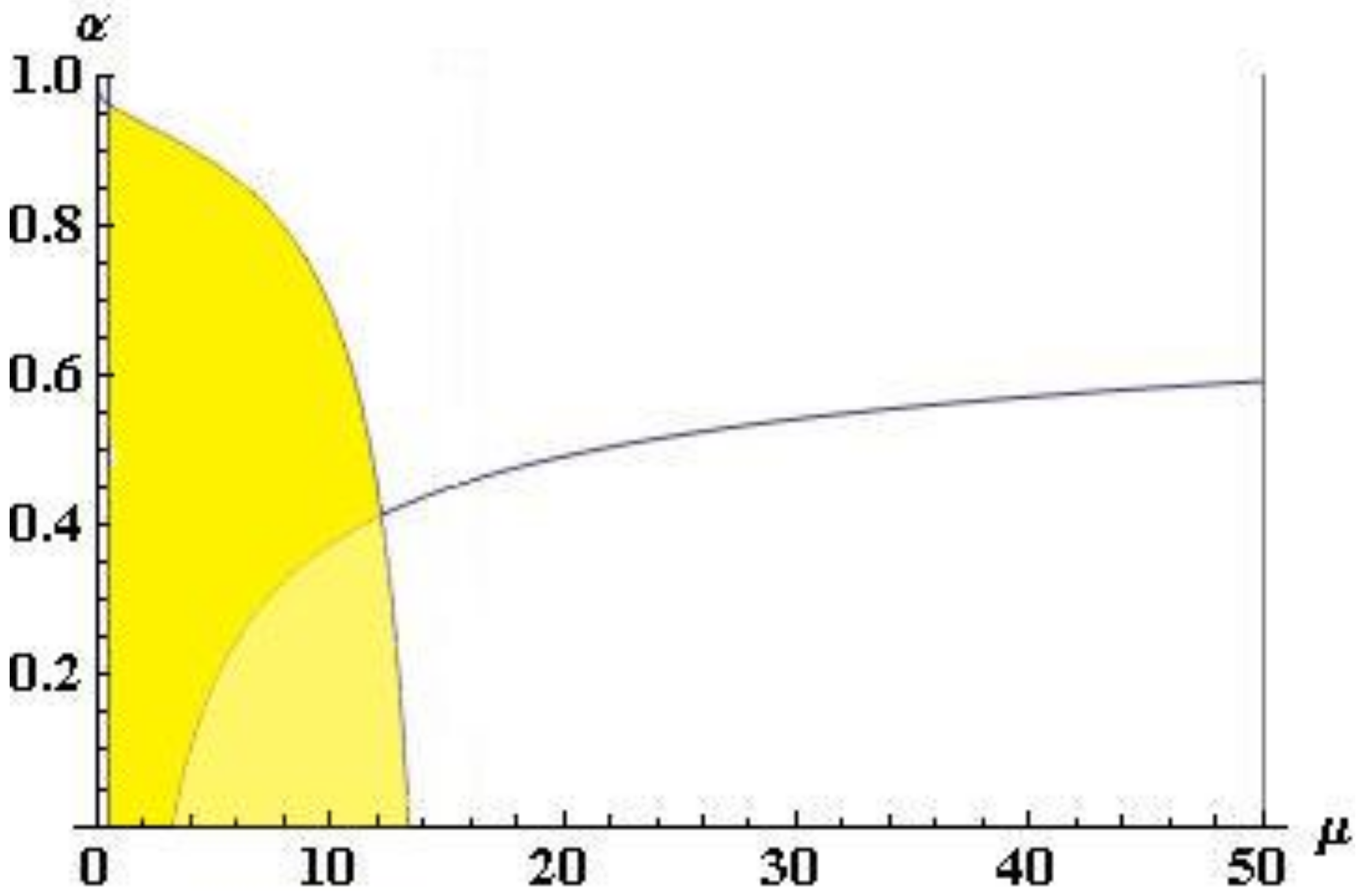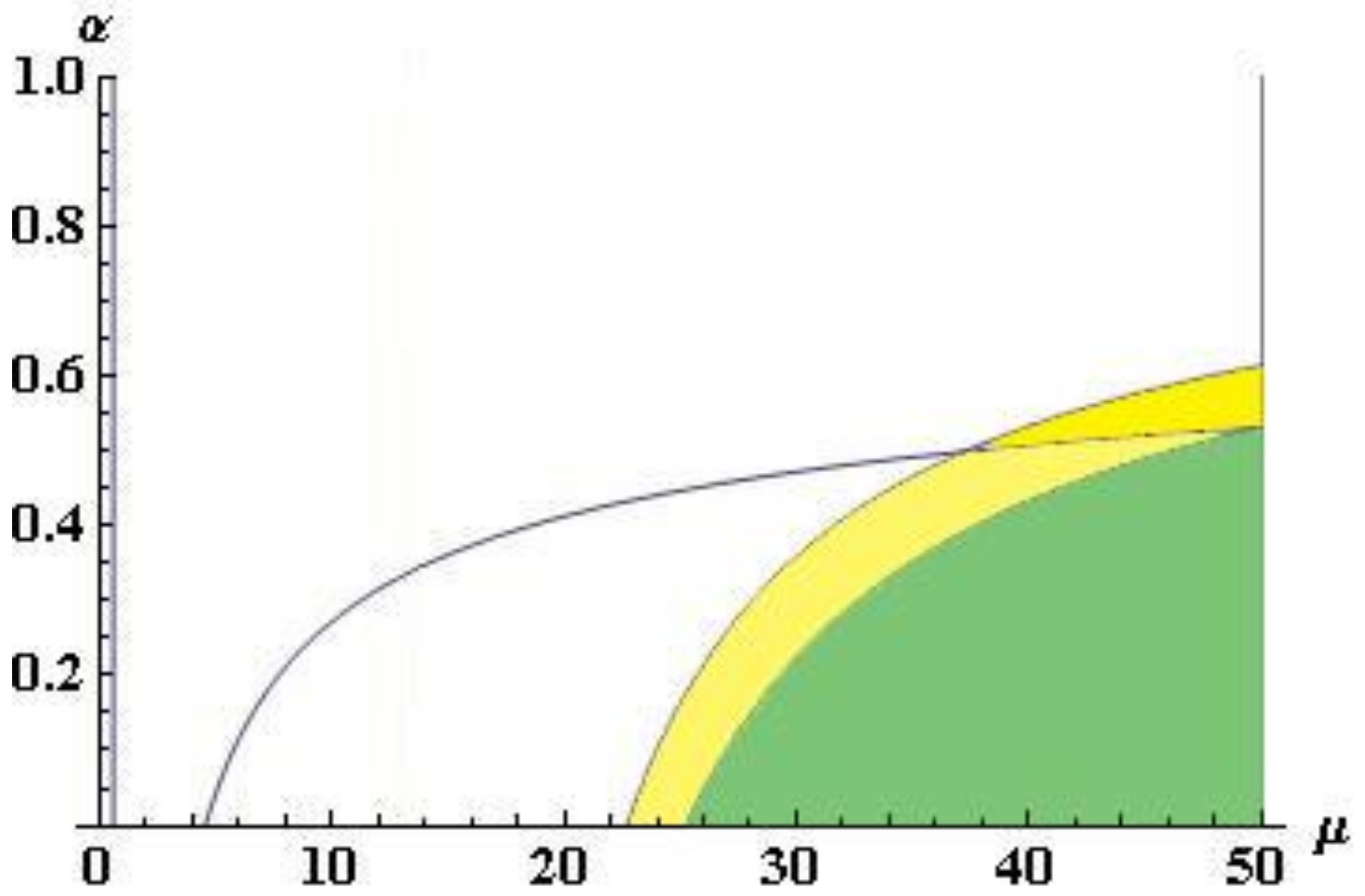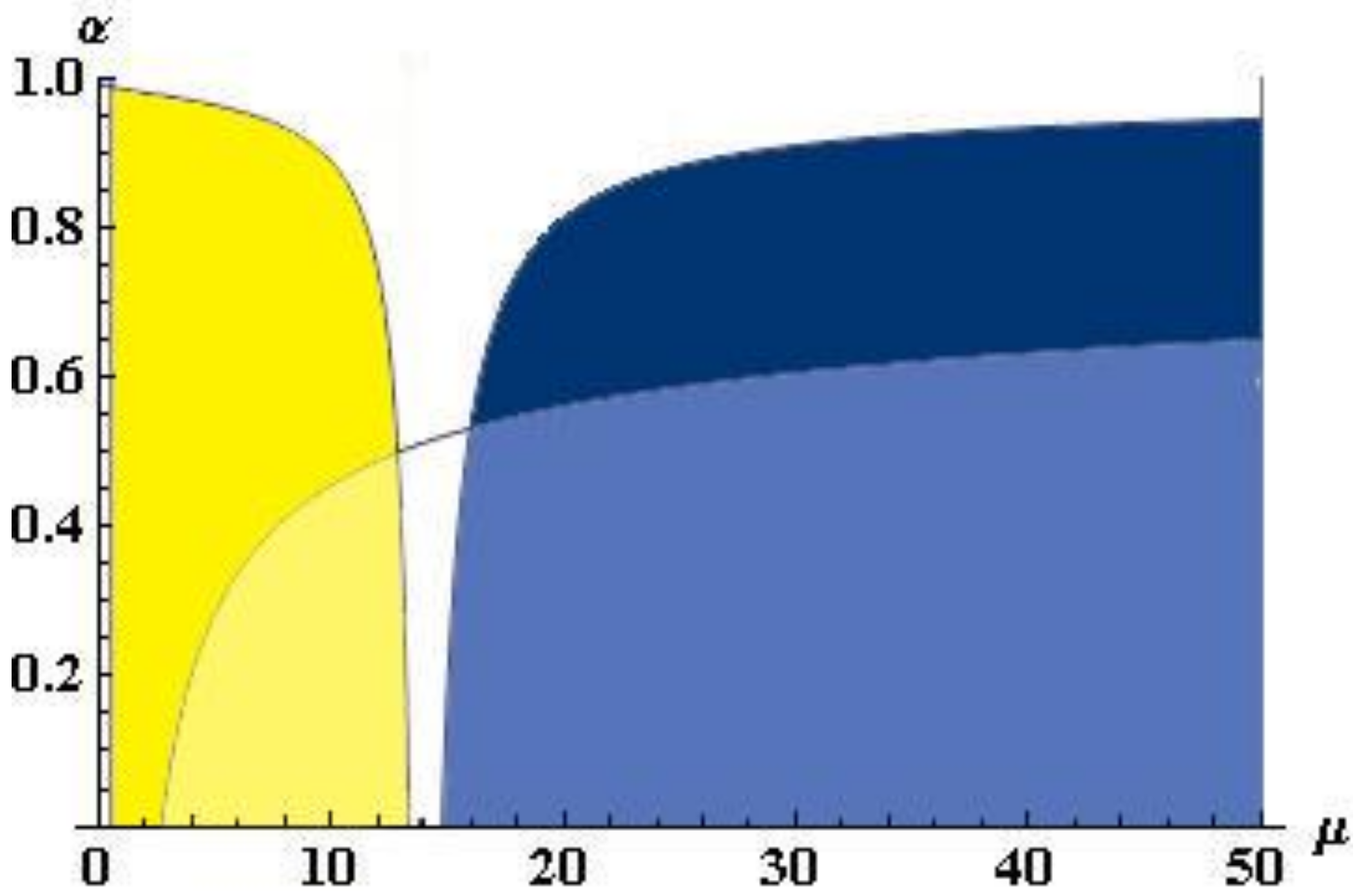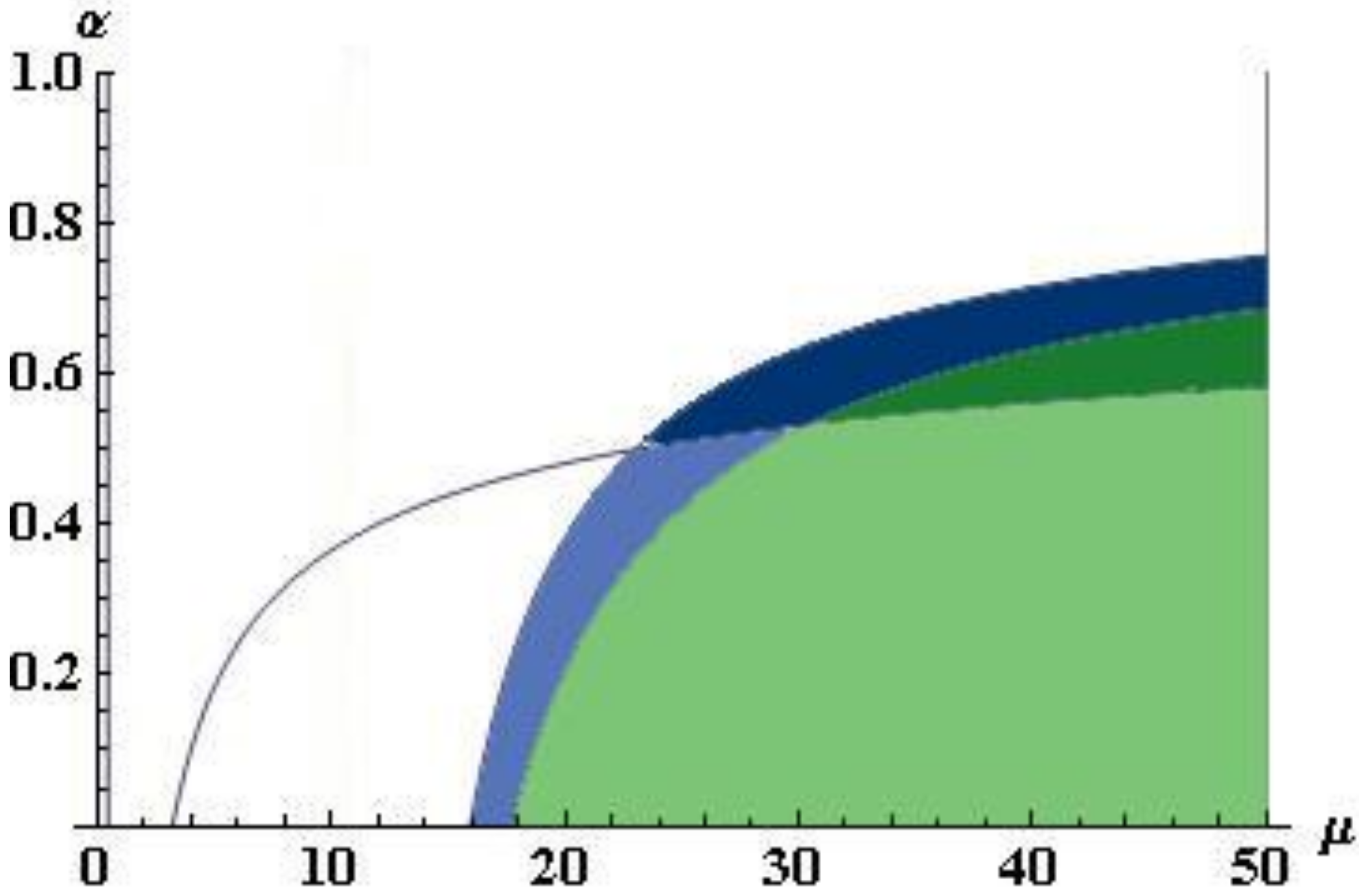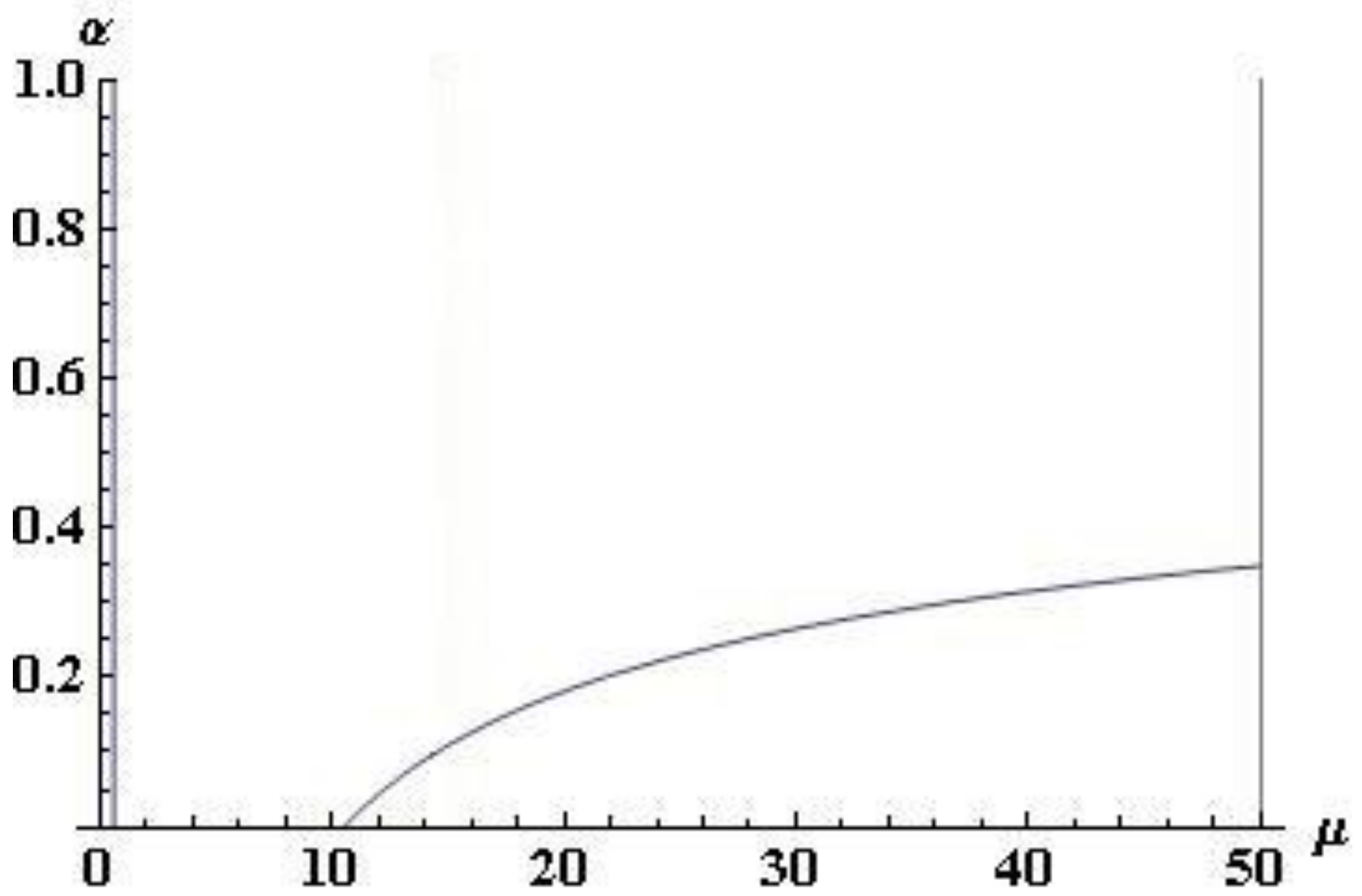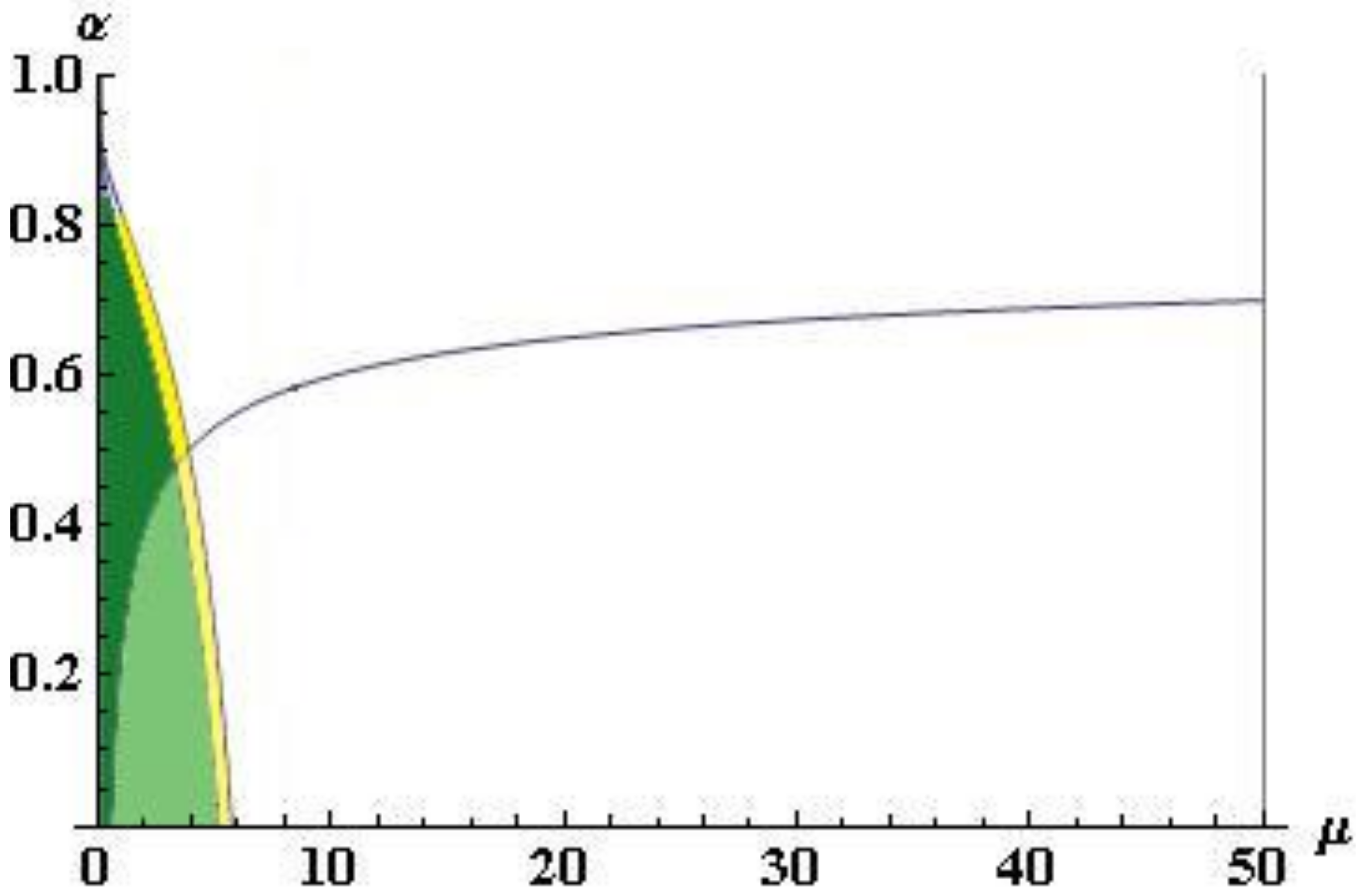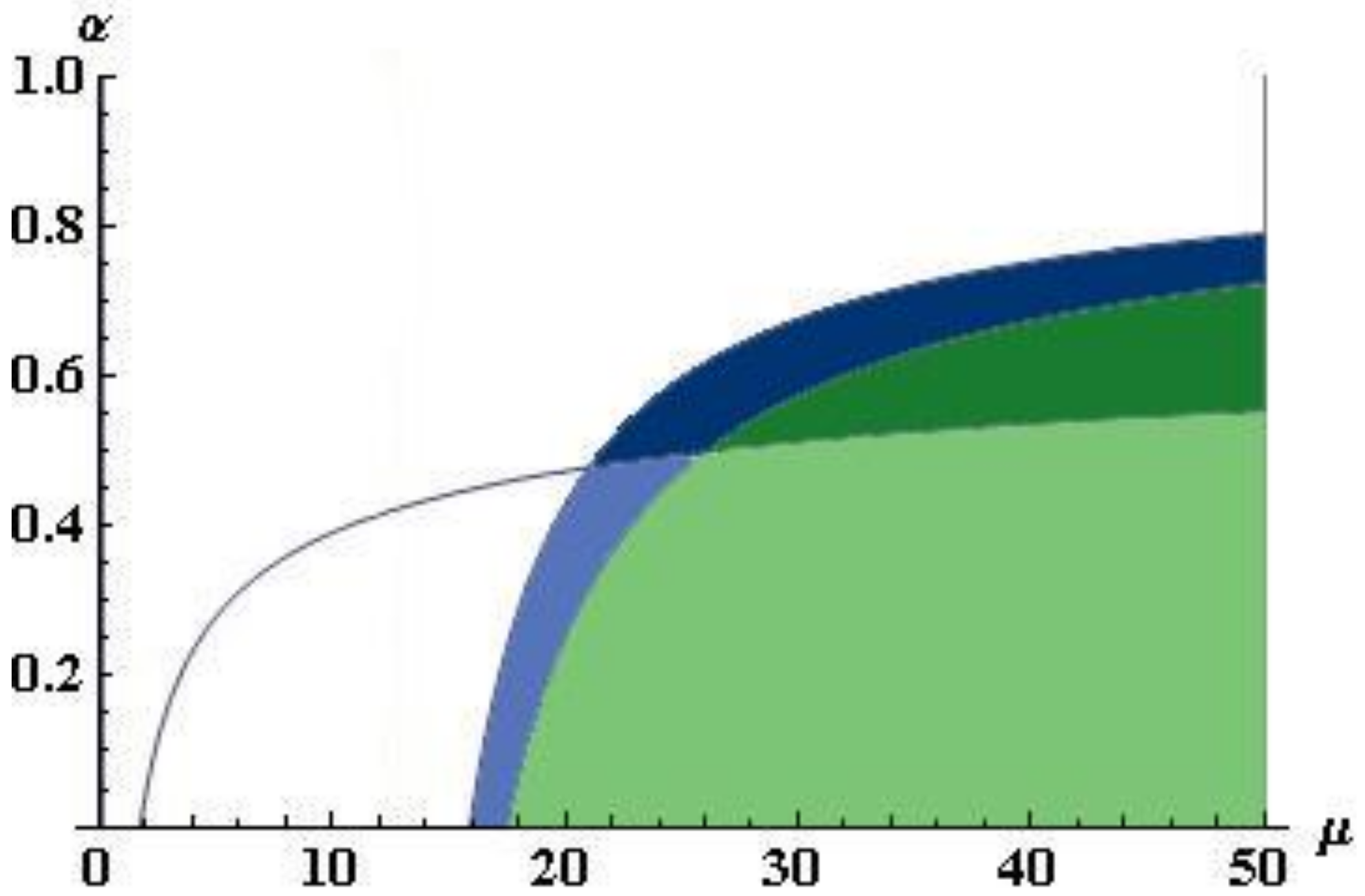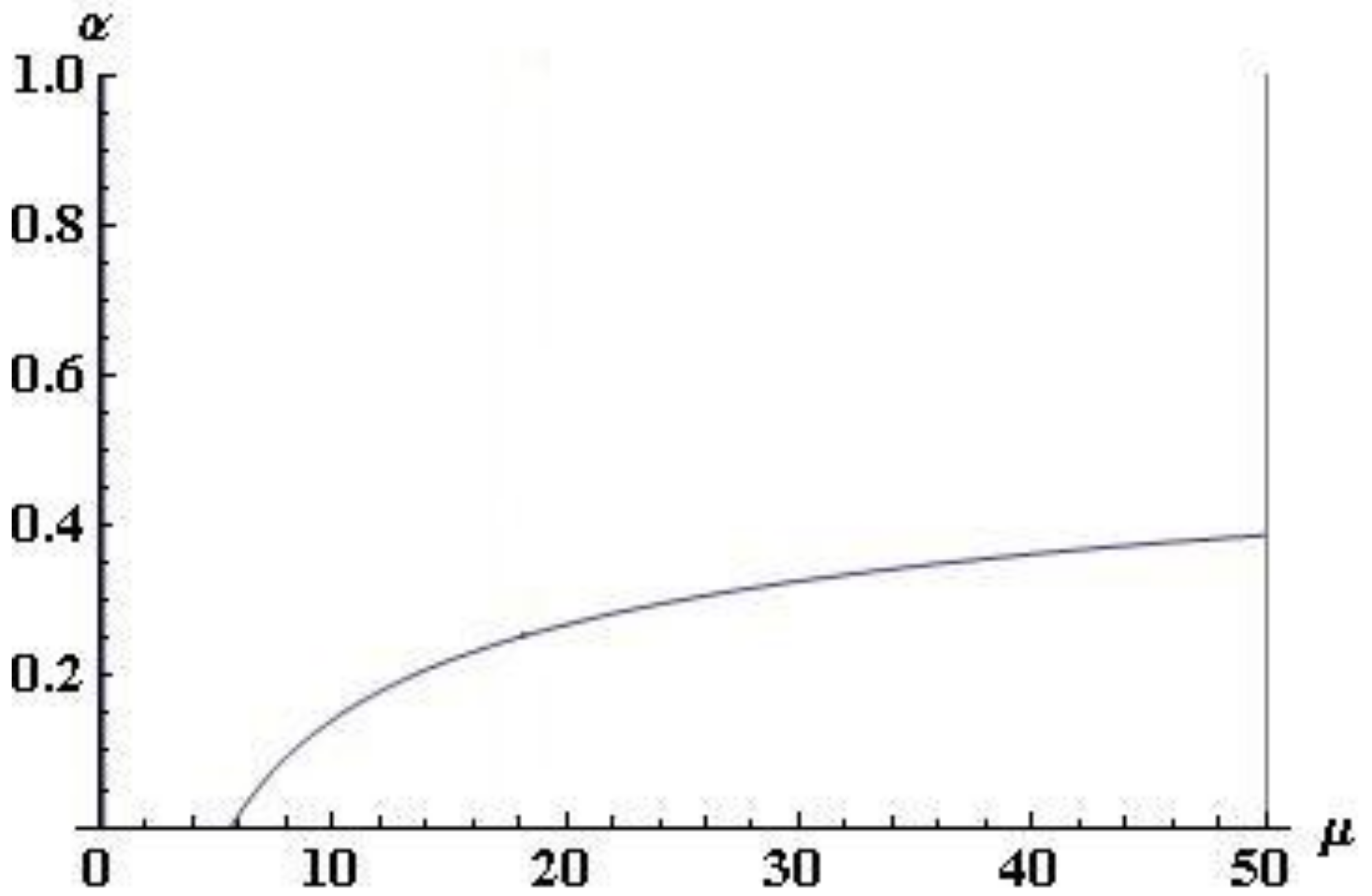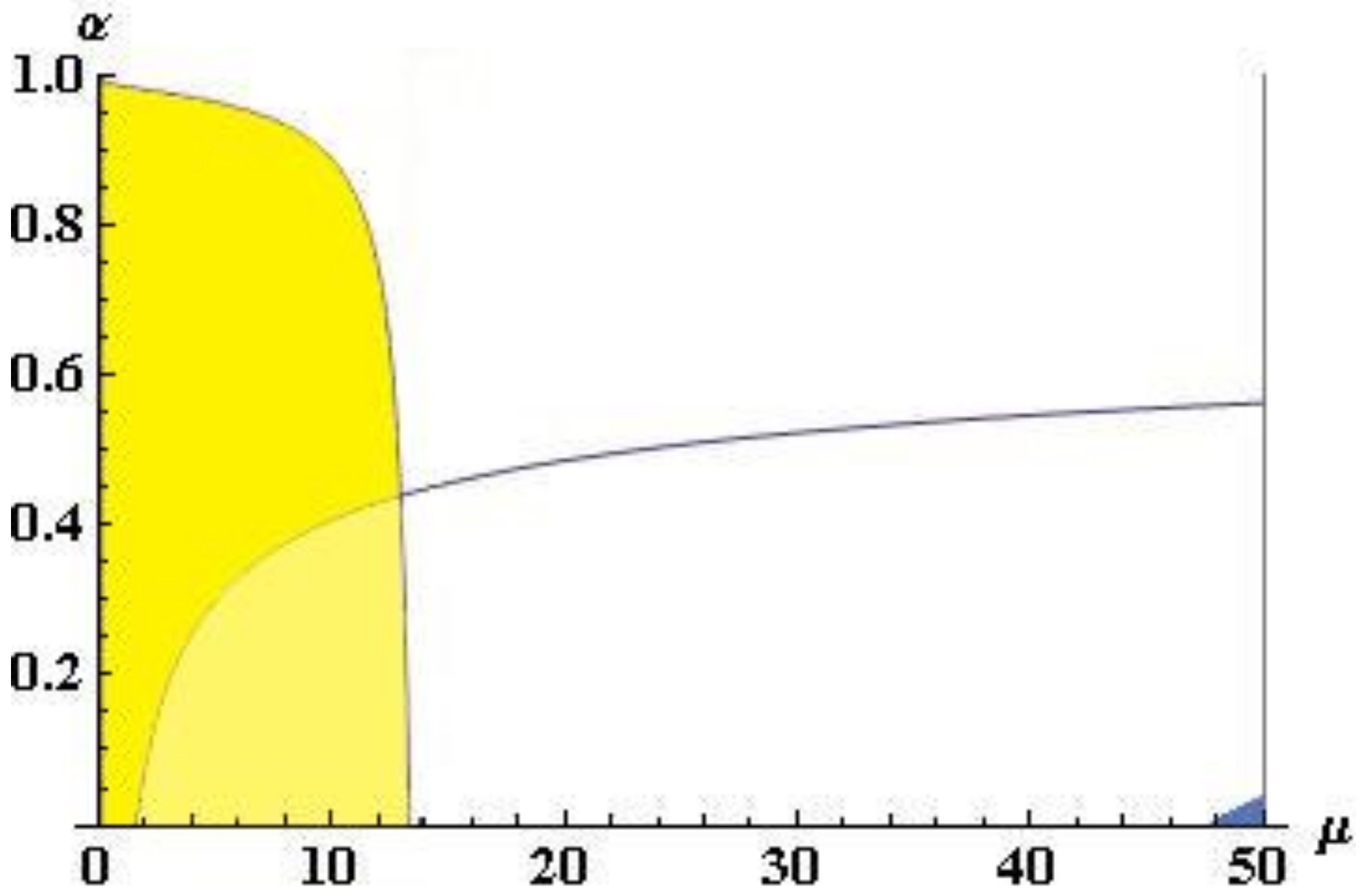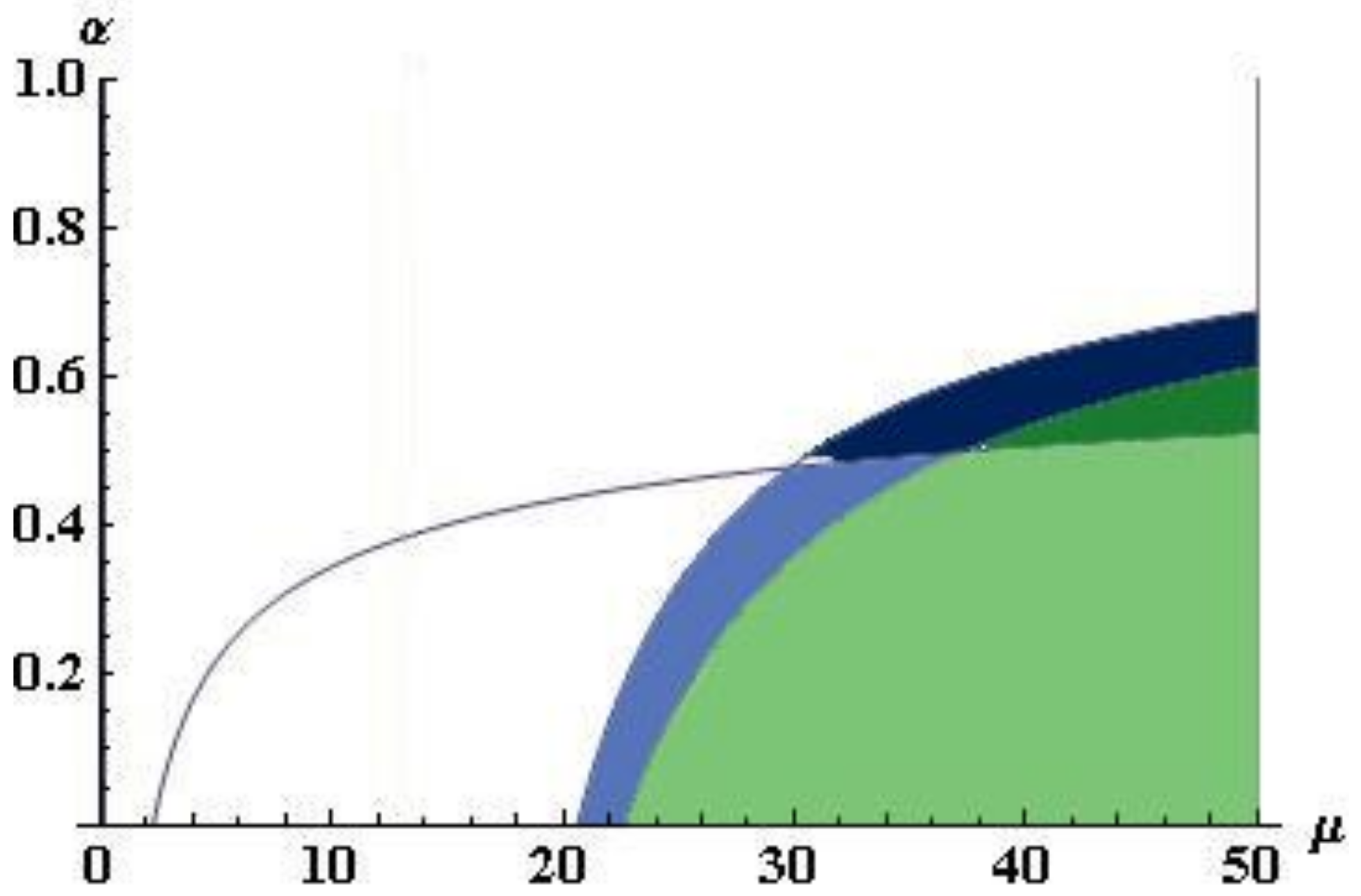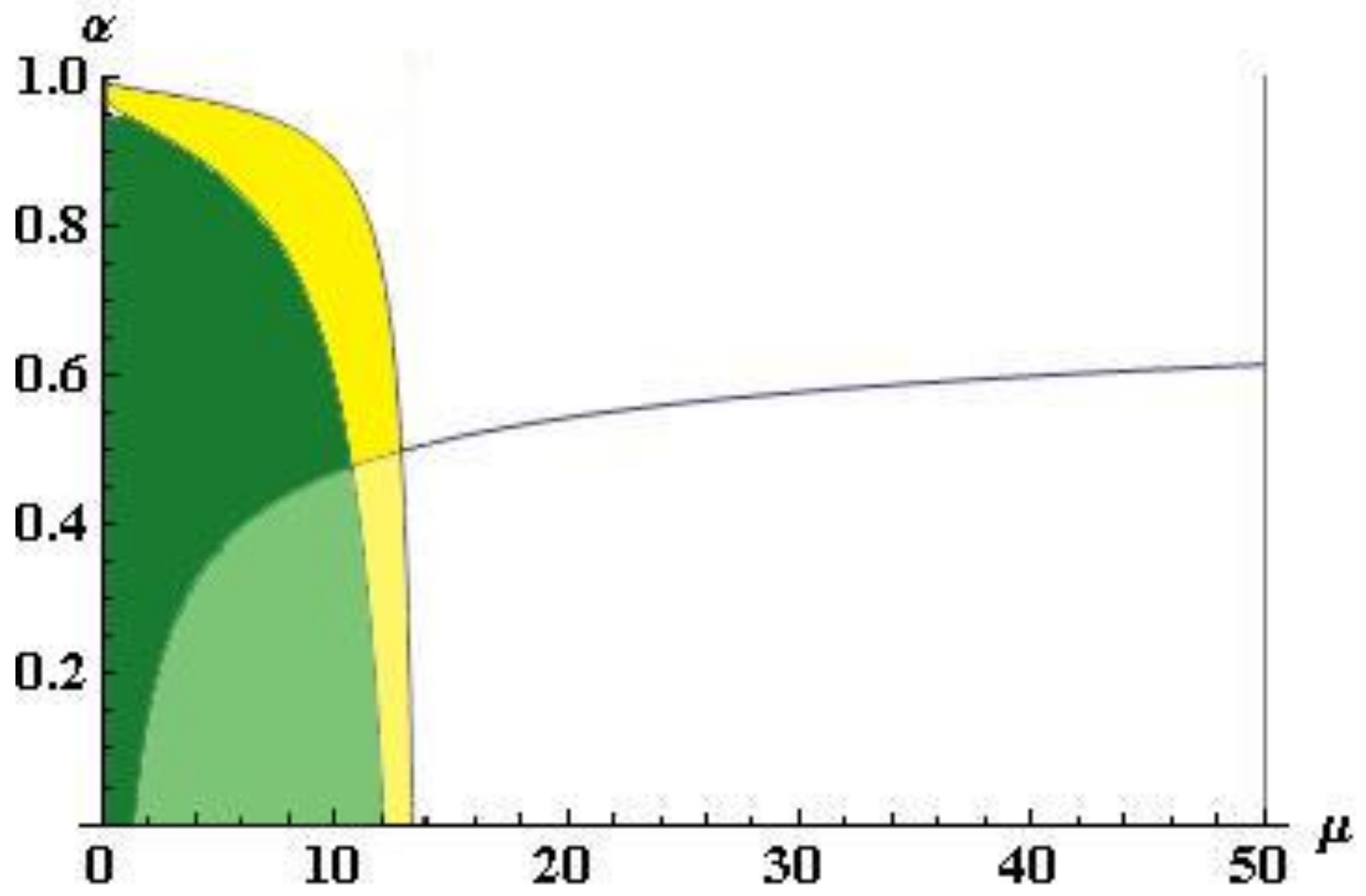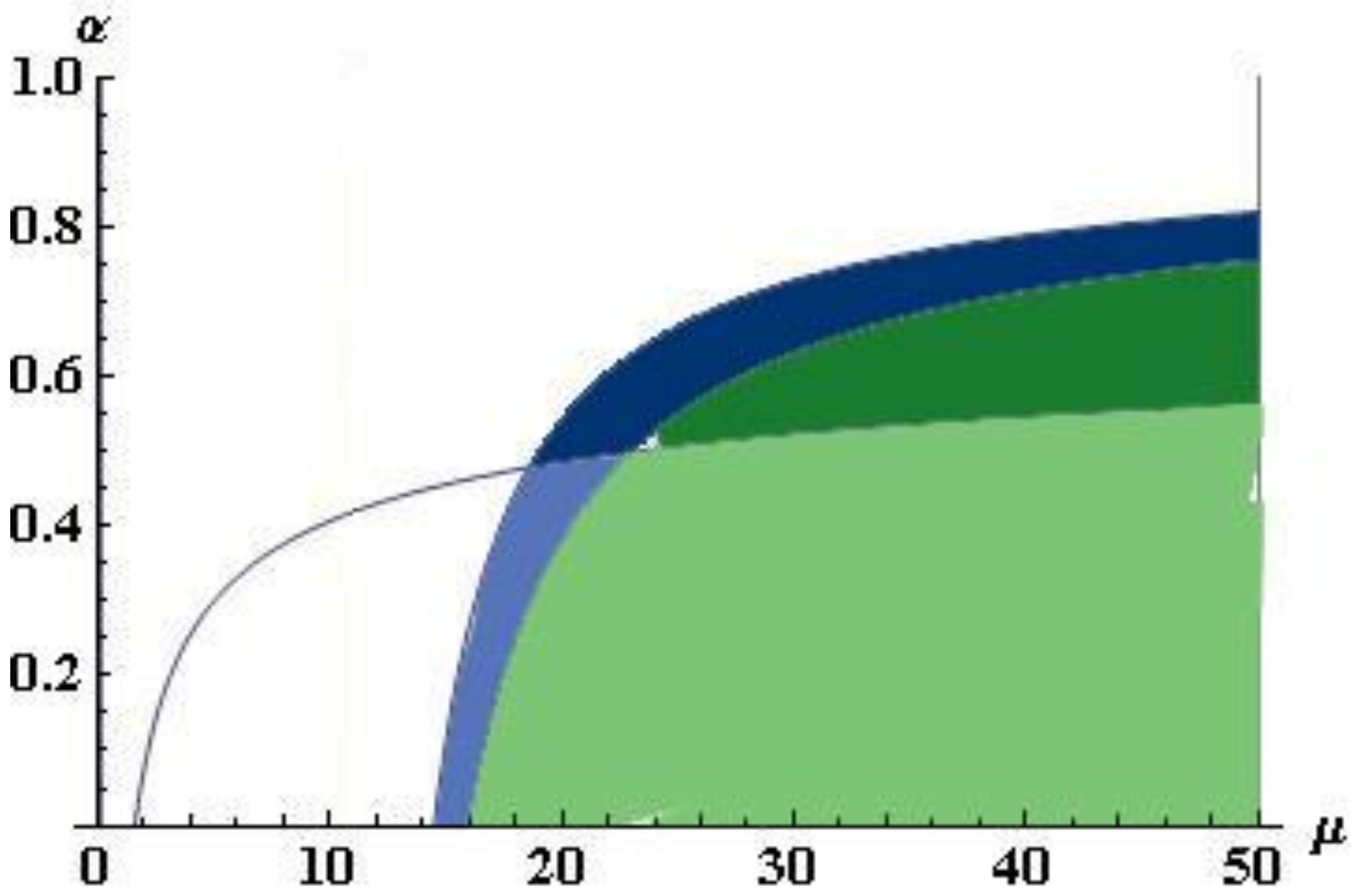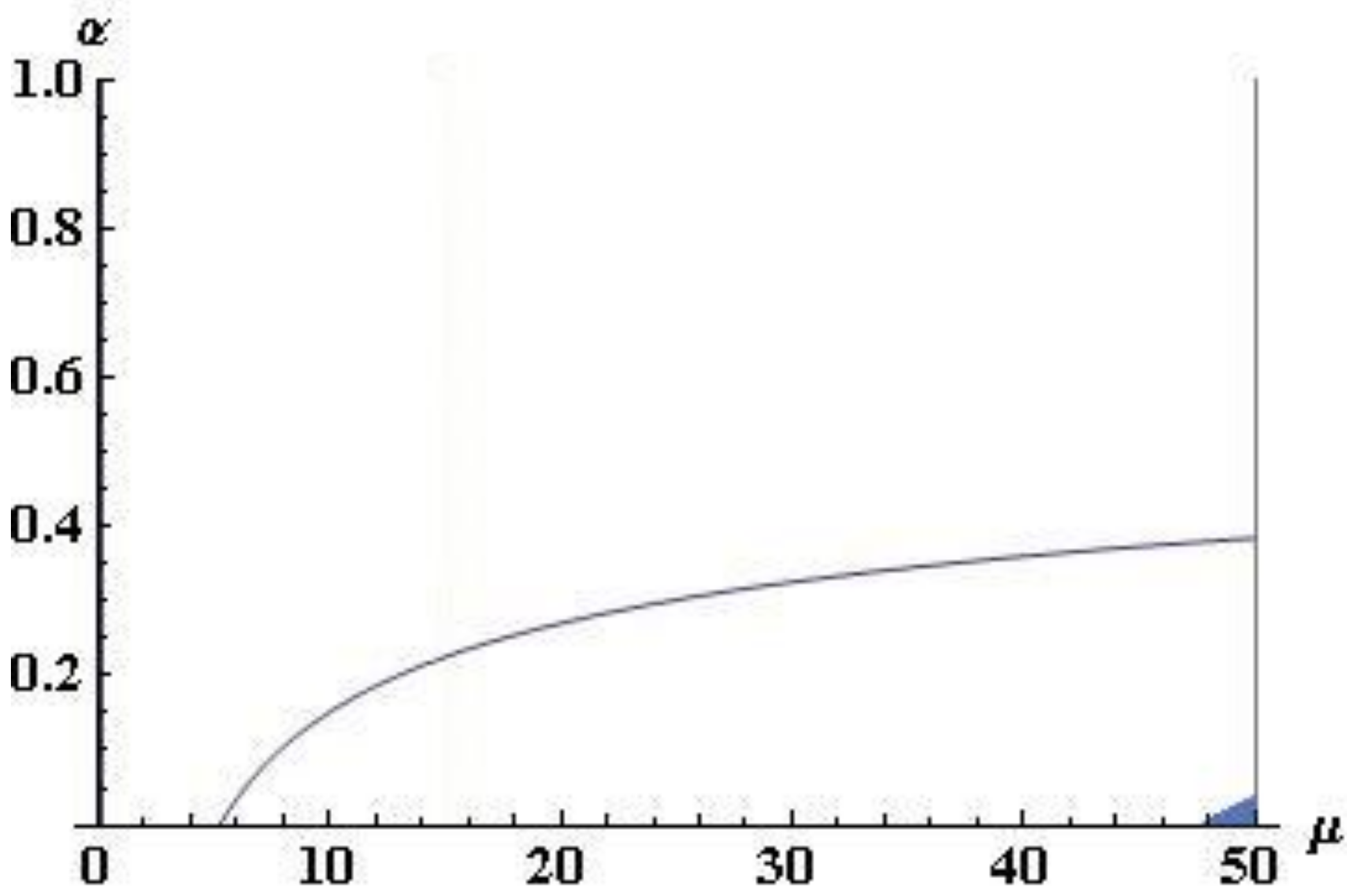1. Introduction
Researchers have described environmental sustainability in diverse ways [
1,
2,
3]. To investigate a national-level sustainability model that relies on quantitative data as a proxy for reality, it’s necessary to choose a sustainability model that can be calibrated using empirical data at a country level. The ecological footprint (EF) is a suitable choice because it measures the direct and indirect impacts of humans on their environment, and thereby makes it possible to assess a representative individual’s environmental impacts. To allow a quantitative analysis, I have defined EF as the land area required to sustain that representative individual, based on current ecological conditions and consumption.
Sustainability is likely to require a combination of improved technology and changes in ethical values [
4]. However, changes in consumption or in the individual’s perceived responsibilities to nature, the current generation, and future generations, whether simultaneously or separately, might lead to policy decisions that are unable to solve the problem of excess assumption or that are unfeasible [
5].
National-scale environmental ethics arise from diverse cultural factors that affect an individual’s perceived responsibilities [
6]. Due to how strongly religion has shaped and continues to shape culture, it is helpful to consider how the ethical characteristics of the world’s main religions have defined the conditions that constrain sustainability. To choose religions at least somewhat objectively, I used the following criterion—the religion’s self-defined adherents must account for at least 20% of the world’s population. Judaism does not meet this criterion, but I included it in my analysis for two reasons. First, Judaism suggests an approach that achieves sustainability by maximizing the welfare of current and future generations subject to sustainable use of the available resources; as such, it lies between a-growth, whose goal is to maximize current welfare without compromising a sustainable use of resources, and strong sustainability, whose goal is to maximize both current and future welfare, while maintaining inter-generational equity in resource use [
7]. Second, Judaism’s approach to sustainability resembles the lifestyles in most secular Western countries, which have increasingly become a goal for citizens of countries around the world [
8].
In the present study, my goal was to develop a framework for considering the impact of the dominant religious ethical principles on sustainability that accounts for differences in the relative importance of consumption of environmental resources and differences in how the environment can provide bonding social capital [
9]. That is, I compare the instrumental value (meeting human needs) with the intrinsic value of nature. The framework accounts for differences between an anthropocentric approach that emphasizes the importance of humans and a biocentric approach that assigns value to both human life and non-human life by considering the “dignity” of non-humans and the environment [
10]. It also accounts for intragenerational equity (equity among members of the current generation in terms of fair distribution of environmental resources, welfare, and of consumption goods) and inter-generational equity (equity between the present generation and future generations), for population dynamics, and for the individual’s perception of their needs for consumption goods, their desired welfare, and the associated use of the environment. The analysis has three main goals:
To empirically assess whether sustainability solutions based on religious environmental ethics are feasible (i.e., whether there are realistic parameter values such that ethics can achieve its goal) and reliable (i.e., whether there is a strong relationship between ethics and its goal) at a national level. For example, could a Muslim country achieve sustainability based on Islamic environmental ethics?
To theoretically discuss whether certain aspects of a religion’s environmental ethics are consistent with the need for sustainability. For example, could a Buddhist country rely on the high importance of the environment as bonding social capital and the dignity of non-human lives to achieve sustainability in the context of increasing consumption?
To empirically assess the global-scale effectiveness of religious environmental ethics for achieving solutions to sustainability problems. For example, which combination of values for religious environmental ethics is most likely to achieve sustainability if countries converge on similarly unsustainable conditions?
Note that in this analysis, I shift the focus from the suggestions provided by secular environmental ethics to the prescriptions and proscriptions of each religion’s ethical code. To define this guidance, I consulted English translations of religious texts from Hinduism (the
Veda,
Purana, and
Mahabarata), from Buddhism (the
Tipitaka), from Judaism (the
Old Testament), from Christianity (the
New Testament), and from Islam (the
Qur’an) to identify clear, authoritative statements that describe each religion’s environmental ethics. My interpretation of Genesis
Section 1 and
Section 2 is based on the Cartesian distinction between the worlds of humans and nature [
11]. This choice has two main justifications. First, this dichotomy distinguishes Judaism, in which Genesis 2 describes humans as “stewards” for future generations, from Christianity, in which Genesis 1 describes humans as “dominators” or “masters” over other forms of life. This, in turn, permits a quantitative test of White’s statement that “Christianity made it possible to exploit nature in a mood of indifference to the feelings of natural objects”, based on the separation of humans from nature, creation of humans in the image of God, and ranking of humans as dominators of nature. This dichotomy also distinguishes between the rights of human generations, whether current and future, and the rights of non-human lives [
12]; intra- and intergenerational equity from interspecies equity (i.e., whether Earth’s resources should be shared by humans and non-humans) [
13]; and altruism focused on humans vs. biosphere-focused altruism [
14].
The dichotomy, therefore, lets us examine how differences in rights within and between generations, differences in equity within and between generations, and human-focused altruism affect our ability to achieve global sustainability. It also lets us consider how differences in the rights of non-humans, the resulting interspecies equity, and biosphere-focused altruism can be combined in a way that acknowledges nature’s intrinsic value and how this shapes the individual’s perception of their duty to nature [
5]. By consulting the above-mentioned primary texts rather than relying on secondary sources, I have tried to avoid the need to settle centuries of debate over religious precepts and over the relative authority of competing interpretations of different versions of a given sacred text [
15]. To constrain my analysis to a manageable level, I have excluded the indigenous religions of Africa and other continents that are based on oral traditions, as they provide no canonical texts for me to analyze in an effort to infer appropriate parameter values. Nonetheless, future researchers could certainly extend my analysis to include such traditions. Finally, by considering religious principles, I avoided the need to rank national-scale secular environmental policies; instead, I focus on how insights from each religion’s sacred texts affect attitudes towards sustainability.
Specifically, this paper provides numerical, analytical solutions that start by characterizing religious environmental ethics. I continue by contrasting two extremes: An individual perspective in which the environment should be preserved to support the greatest possible consumption for individuals in current and future generations, and a communal perspective in which the environment should be preserved to support the happiness individuals receive from belonging to a local or global community. To support this analysis, I have relied on the following definitions and assumptions:
Efficiency means achieving the maximum output per unit consumption of an environmental resource or the minimum consumption for a given output. I take this as given, and measure efficiency based on current technology rather than extrapolating future technology. However, I will also explore whether improved technology could mitigate the environmental impact of consumption.
Equity is based on fairly distributing a good or service, and applies to current and future generations but not to non-humans. Although applying equity to all generations (both current and future) can solve a sustainability problem, it can instead prevent sustainability when applied only to the current generation. That is, global sustainability can be achieved if all countries except the United States decrease per capita consumption to the level in Bangladesh, but cannot be achieved if all countries try to achieve the same per capita consumption as the United States.
Justice means positive or negative rights to support actions or interests, and applies only to current humans. It does not apply to future humans or non-humans, although we can also consider the effects of a sense of duty towards future generations, consider the inherent worth of the environment, or accept the dignity of non-human lives. That is, different rights equate to different perceptions of dignity, but not vice-versa.
Finally, the analytical and numerical solutions developed in this study depend on current and future populations and their perceived needs, in terms of both (current) welfare and (current) use of the environment. This is because both parameters are likely to change temporally and spatially.
These formalizations reveal the aspects that are shared by pairs of religions. For example, Catholicism’s recent extension of dignity from humans to all of creation approaches the Hindu perspective. Moreover, trying to apply the same approach to everyone (universalism) may postpone cooperation until a consensus is achieved about the most appropriate worldview, whereas basing the approach on each religion’s ethical code can be implemented at a community level, since each religion can rely on its own principles rather than waiting for a global consensus [
16]. Finally, these formalizations reveal differences among religious ethics. For example, Judaism defines an imperfect, created sacred nature that has the consequence of assigning
small importance to the environment as a form of bonding social capital; in contrast, the perfect and uncreated sacred nature defined by Buddhism has the consequence of assigning the
same dignity to humans and non-humans.
There is no mathematical literature on the feasibility of religious environmental precepts, whereas the statistical literature on reliability of religious beliefs and/or communities [
17] is often based on pro-environmental concerns, attitudes, intentions or self-stated environmental behaviors rather than on observed environmental behaviors (see
Supplementary Materials I). By taking a national perspective (see
Supplementary Materials II), which accounts for both religious beliefs and communities, the present study relies on an original panel dataset on majority religions (to avoid problems in identifying people belonging to a specified religion based on self-stated attendance at religious ceremonies, adherence to religious precepts, or private prayer activity) and observed ecological footprints at a country level (to avoid the gap between an individual’s expressed beliefs and their actions, to elicit persistent rather than situational influences on behavior, and to minimize the gap between reality and the simulation).
This paper’s main contributions lie in how the approach represents religious environmental ethics from the analyzed religions within a single mathematical framework (to achieve insights about feasibility based on numerical analyses), and in how the framework is based on variables that can be quantified (to achieve insights about reliability based on statistical analyses). This also supports comparisons of feasibility, effectiveness, and replicability of each religion’s environmental ethics to achieve local and global sustainability, by considering religious environmental precepts as a policy rather than as personal traits, learning styles, and values. This analysis can be applied in similar contexts, such as whether a more equal income distribution can be achieved in the future, or in contrasting contexts, such as the distinct contexts of pre-industrial, industrial, and post-industrial economies. The advantage of a mathematical approach is that the analysis becomes more objective because the underlying assumptions are clearly defined. Future researchers can modify the assumptions based on empirical data or can explore the effects of alternative assumptions. This approach permits more objective comparisons among alternatives, and it can be expanded in future research to account for different schools of thought within a religion or different cultures. Finally, quantification mitigates subjectivity and provides new insights by taking advantage of the ability of mathematics and statistics to detect key factors that might otherwise be missed.
It’s important to emphasize that this paper is not intended to be a deterministic model that will accurately predict the ecological fate of different religious groups based solely on a simplified depiction of their religious precepts; rather, the goal is to use mathematics to obtain a more rigorous description of the selected religious precepts and use that description to seek insights into their implications for ecological sustainability. Without a theoretical model that can be supported by empirical data, it is difficult and may be impossible to explore whether a country can rely on the precepts of its dominant religion, which precepts are most important, and which religions are most likely to support ecological sustainability. The goal of the present study was to develop a theoretical model to support such discussions, and then use empirical data to demonstrate how the model can generate novel insights from real-world data to support such discussions. In other words, the goal of this paper is not to propose a deterministic model of human behavior that predicts inevitable outcomes; rather, it is to provide insights that might otherwise be missed by alternative methods, and insights that can be subjected to a reality check.
2. The Theoretical Framework
The mathematical model to depict pro-environmental behaviors of a representative individual at a national level is described in
Appendix A. Note here that formalizing parameter values based on the sacred texts of each religion requires precision, to ensure that the results are reliable, and simplification, so that it is not necessary to consider doctrinal differences within a religion. I have, therefore, grouped some religions based on philosophical factors that make them more similar than different in the context of the analytical framework. This let me provide examples (quotations) from the sacred texts that will let readers assess the consistency of my simplifications with these texts (see
Appendix B). Moreover, I have represented some religious moral precepts related to nature as
objectives. For example, human dominion over non-humans in Jewish texts becomes the objective of maximizing inter-generational welfare. In contrast, I have depicted some religious moral precepts related to nature as
constraints. For example, the Islamic trusteeship of the environment to preserve it for future generations becomes a sustainability condition that must be met. Finally, I have represented some religious moral precepts related to nature as
parameters. For example, the sacred creation of nature described in the Eastern Orthodox texts of Christianity can be represented by a large value of μ.
I have not considered the relationships between divine precepts and natural laws (i.e., the extent to which divine laws are translated into the natural order); I have not considered the relationships between religions and politics (i.e., the extent to which divine moral norms should be translated into secular behavior or order); I have quantified sustainability based on the EF for the world population (θ) in a given year, and have assumed that the future welfare will be at least as high as WC. We can, therefore, simplify the notation by replacing WC with w, and use w as a reference for future generations.
In summary, I have represented feasibility using pairs of α and μ values that meet sustainability condition θ (i.e., the maximum global EF that permits sustainability) for alternative values of m, n, ε, and ζ in alternative contexts. I do this for a given level of w, with λ quantified as the current national or mean global level of environmental technology. Increasing α means increasing the importance attached to individual consumption, while decreasing the importance attached to community involvement, whereas increasing μ means increasing the importance attached by the community to the environment, while decreasing the importance attached to consumption.
2.1. Hinduism (Including Jainism)
Hinduism emphasizes stewardship, an extended family of Mother Earth (i.e., one that includes all living beings), respect (based on the birth and rebirth cycle) up to reverence (based on the supreme being’s incarnation) for non-human species, harmony with all of divine creation, and ensured wealth (greater than some minimum) for everybody. Hinduism combines this with spirituality related to the environment and a belief in punishment in future reincarnations for acts that contravene the rules of dharma [
18,
19,
20,
21]. Mathematically (where HIN represents the value for Hinduism):
With
m ≥ 1. Thus, solutions can be represented as follows:
Jainism provides precepts on non-violence, not-stealing, and non-possession.
In summary, this proposed lifestyle goes beyond that of the deepest ecologists [
22]. Mathematically,
Ei ≤
s < θ, where
s is the subsistence-level use of the environment. However, I have not included this minority religion (i.e., 0.3% of the world’s population in 2012) in the rest of my analysis because it would be infeasible to extend it to a large population. Similar formalizations can be made for Sikhism [
23].
2.2. Buddhism (Including Confucianism and Daoism)
Buddhism focuses on harmony with nature’s laws, extends compassion and loving-kindness to all beings, preserves nature for its aesthetic value, and predicts both individual and social punishment as a consequence of detrimental actions [
24,
25]. Mathematically (where BUD represents the value for Buddhism):
where
m > 1, and where
eBUD and
wBUD represent needs in terms of the use of the environment (e.g., human waste) and in terms of welfare (e.g., human and non-human pain), respectively. The desire to escape from the world’s temptations implies a small α. Thus, Buddhism and Hinduism have similar precepts related to environmental actions, although they sometimes have different foundations. For example, Hindu respect for animals derives from animals having been human in a previous life or humans becoming animals in a subsequent life; in contrast, Buddhism’s respect for animals is based on the belief that animal suffering is equivalent to human suffering. This suggests that Hinduism’s equilibrium environmental solution (
Section 2.1) could also be used for Buddhism. Here, I have used
equilibrium for the result after simultaneously accounting for the offsetting effects of all variables, with sustainability maintained for both current and future generations (i.e., a steady-state or static equilibrium).
Confucianism can be seen as a secular rather than a religious code of ethics (i.e., rules for harmonious co-existence with other humans) because it lacks a strong sense of transcendence in an afterlife. Nonetheless, it is strongly concerned with human well-being. In summary, nature ultimately comprises a single energy source (
Qi); harmony arises from the ongoing generative actions of
Yin and
Yang; and social order and balance in large ecological systems arise between humanity and nature, accompanied by love for natural beauty [
26,
27]. Mathematically:
where the weighted sum refers to the relevant (local) community, with
ri as the relative weight for individual
i. Thus, Buddhism (for individuals) and Confucianism (for a community) rely on similar precepts related to environmental actions. This suggests that Buddhism’s equilibrium environmental solution can be used for Confucianism in a national-scale analysis.
Daoism focuses on harmony with nature, with nature perceived as a flux. It also focuses on human health, which is perceived as an equilibrium between the body and its environment [
28,
29]. Note that Daoism is consistent with Darwin’s theory of evolution and with an ecosystem approach to sustainability. Mathematically,
Ei ≤
s < θ, where
s is the subsistence-level use of the environment. However, I have not considered this minority religion (i.e., 0.1% of the world’s population in 2012) further because it is infeasible to extend it to a large population. Similar formalizations are possible for Shinto [
30].
2.3. Judaism
In Judaism, humans are “stewards” for future generations, and nature is not, itself, an end; instead, it hints at the existence of the divine creator who governs and sustains it. God is the rightful owner of Israel’s land, and Israelites are God’s tenants. Punishment is provided for sins; preservation of vegetation is emphasized, such as conservation of fruit trees, as is biodiversity and limited consumption of some animals, for unspecified reasons; and fallow agriculture is recommended to restore soil nutrients and maintain vigorous plants [
31]. Mathematically (where JUD refers to the value in Judaism):
The solutions can be represented as follows:
Note that with an increasing population (i.e., n > 1), sustainability conditions become stricter (i.e., a lower αJUD for each μ). Note, however, that the concern seems to focus on future Jewish generations, not all future generations. Moreover, the formalized rules prescribe or proscribe inter-temporal optimal use of natural resources by current and future generations rather than prescribing preservation of nature, although Deuteronomy describes how to manage soil, animals, and vegetation to maintain their productivity. The second creation story in Genesis (2:7-15) may have been introduced when the Jewish people replaced a nomadic lifestyle with a sedentary agricultural lifestyle to solve problems, such as land degradation and desertification. Unlike the situation for nomadic peoples, sedentary peoples cannot spread their food risk over large areas. In contrast, the first creation narrative (Genesis 1:1-23) describes creation of the material world as the imposition of order on chaos and provides a rationale for distinguishing between the sacred and the profane. Finally, nature (i.e., God’s creation) is imperfect (i.e., it must be redeemed together with the redemption of the people of Israel), and human management and care are essential, following God’s divine commands to sanctify nature. In other words, nature is not inherently sacred. However, in terms of the dignity of non-human life, domestic animals are also granted the Sabbath day of rest (Deuteronomy 5:13-14). In addition, rabbinic Judaism called on Jews to strive to transcend nature. Thus, it is difficult to achieve a large commitment to nature (μ) to create a form of social bonding capital.
2.4. Christianity (Catholicism, Eastern Orthodox, and Protestantism)
In Christianity, humans are seen to dominate or serve as masters of non-humans, with no constraints, so that all needs are satisfied [
32]. Mathematically:
In other words, Christians adopted the first creation story (Genesis 1:26-28).
For Catholics, St. Augustine tells us, “Though not required for furnishing of our house, these things [all creatures] are necessary for the perfection of the universe” (
De Ordine). Similarly, St. Thomas tells us, “As those creatures that are less noble than man exist for the sake of man, whilst each and every creature exists for the perfection of the entire universe” (
Summa Theologica). In summary, Catholics should admire nature, as God provides nature as a common good to meet human needs (i.e., instrumental values), and imperfect nature must be altered by humans [
33,
34,
35]. Mathematically:
The first Catholic mention of “social injustice” appears in Pope Leo XIII’s Rerum Novarum, and supports ε = 0. In contrast, more recent theology prioritizes caring for the community (e.g., in Latin America) before caring for creation. Moreover, m = 1 represents the belief that humans and non-humans must be judged by different standards. Indeed, Pope John Paul II wrote, in Peace with God the Creator, Peace with all of creation, that “respect for life and for the dignity of the human person extends also to the rest of creation” and that “Christians realise(sic) that their responsibility within creation and their duty toward nature and the Creator are an essential part of their faith”. In other words, Catholicism resembles Hinduism (i.e., 1 < m < ∞), without mentioning sustainability, although human morality depends on divine grace and on faith. For example, early settlers of North America treated indigenous peoples as non-human because they had not yet been “saved”. However, Darwin’s theory of evolution does not support the use of different standards for humans and non-humans, unless “God is love” (John 4:16) and creation is not a one-time event, but rather a continuous giving of life by the Holy Spirit. Finally, Catholicism’s treatment of non-humans and Earth’s goods as “resources”, as in the Second Vatican Council (1962-1965), reveals the absence of any sustainability concept, and suggests that Earth should be subdued to meet human needs (i.e., Wi ≥ w for each individual i).
Note that in the
Life of St. Francis, by St. Bonaventure, St. Francis says “Lord, I thank thee for the sufferings thou art sending me. Send me more, if it be thy good pleasure. My pleasure is that you afflict me and spare me not, for the fulfilment of thy holy will is the greatest consolation of my life states”. In other words, we achieve happiness by complying with God’s will (i.e., α ≈ 0), which is represented by creation and by natural events, such as disease and other trials of the flesh (
infirmitate et tribulationes). Only humans have freedom. St. Francis refers to water, sun, wind, and land as brothers and sisters, thereby suggesting that creation has the same dignity as humans (i.e.,
m > 1). This resembles Hinduism. However, non-humans are not mentioned, which is consistent with the belief that humans and animals are fundamentally different: St. Francis’ speeches to animals (e.g., birds, wolves) are instead aimed at specific human social categories (e.g., poor people, pagans). St. Francis states that we should use nature only enough to achieve a subsistence life (i.e.,
E ≤
s). Mathematically:
Thus, sustainability is achieved if s ≤ θ.
In the Eastern Orthodox religion, one should live in faith and love by following the contemplative life (
vita contemplativa) and withdrawing from the created world; God is omnipotent and independent, whereas the world is limited, dependent, and incomplete without God. Despite this, the Holy Spirit lets us combine the divine unity, divine transcendence, and God into creation [
36]. Mathematically:
with a large μ and a small α. Thus, sustainability is achieved if
e ≤ θ.
Protestantism focuses on nature as a manifestation of God, on anthropocentrism, on an active life (
vita activa) rather than a contemplative life (
vita contemplativa), and on nature’s beauty [
37,
38,
39]. Mathematically:
Note that Protestantism’s approach to social justice (e.g., the “two Kingdoms” doctrine) supports a positive ε, although the ethics of ecological justice are too recent to fix ε = 1. In any event, this would not ensure sustainability.
In summary, Christianity (Catholicism, Eastern Orthodox, or Protestantism) cannot achieve sustainability. Indeed, Christian principles of “equal dignity of humans”, which treats all humans as children of the same God, and “love of neighbor”, which asks us to love each other as God loves us, do not imply sustainability.
2.5. Islam
Islam sees humans as trustees for future generations and requires moderation in the use of natural resources, with the goal of minimizing the environmental impact to the smallest level possible, while still meeting human needs [
40,
41,
42,
43]. Mathematically (where ISL represents the parameter value for Islam):
Thus, solutions can be represented as follows:
Note that women’s role in historical Muslim societies suggests ε = 0. Moreover, the Qur’an’s prohibition against charging interest on loans (4:161, 30:39, 2:275-278; 3:130) suggests preservation of renewable resources at a level close to the maximum sustainable yield. Finally, we can justify m = 1. Muslims must be compassionate towards non-humans, including plants. However, humans alone are gifted with eternal life, and our aims differ from those of non-humans. In other words, all of creation is subject to Allah’s natural laws, but non-humans have a lower dignity than humans.
2.6. Summary of Religious Environmental Ethics
Table 1 summarizes the objectives, constraints, and environmental ethics of the five religions based on the preceding analyses.
Daoism emphasizes non-action and depicts nature as a series of flows through bodies, which implies that environmental equilibrium is sustained by human health; this resembles a more dynamic version of Jainism’s emphasis on asceticism. Moreover, I have depicted all religions as concerned only with the current population (i.e., by normalizing θ with respect to the current generation). The exception is Judaism, which also considers population dynamics (i.e.,
n ≠ 1). Finally, I depict Islam and Catholicism as lacking in concern about social inequalities (i.e., ε = 0), although Catholicism’s recent emphasis on labor rights and Islam’s recent emphasis on women’s rights should be noted.
Appendix C highlights how each religion’s solutions (e.g., whether α increases or decreases with increasing μ) depend on the current values of λ
0 and
w0.
My analysis reveals four novel results. First, all religions that I have analyzed share an inconsistency: They strongly value each individual, both for humans and for non-humans, but when they consider animal lives, their approach to sustainability focuses on the species, not individuals. Indeed: Judaism says “O Lord, all eyes hope in you, and you provide their food in due time. You open your hand, and you fill every kind of animal with a blessing” (Psalms 144:15-16, and similarly, in Psalms 103:2728); Christianity says “Father feedeth them” (Matthew 6:26); Islam says “There is no creature that moves in the Earth but it is for Allah to provide it with sustenance” (11:6); and Hinduism says “Mother Earth, like a Cosmic Cow, gives us the thousand-fold prosperity without hesitation without being outraged by our destructive actions” (Atharva Veda, Mantras 45 and 59).
Second, although the minimum environmental resources required for survival can be used as a target to achieve sustainability by some religions (i.e., Daoism, Jainism), the concepts of the environment’s inherent needs that are shared by many religions (i.e., Buddhism, Eastern Orthodoxy, Islam) do not necessarily represent a consistent standard of comparison; that is, they are an unreliable precept because the concept of needs changes temporally and spatially.
Third, even though belief in nature’s beauty and sacred characteristics, or in nature’s harmony, is supported by each religion, though in different ways, this is not sufficient to achieve sustainability, even if adherents combine this belief with a belief in punishment for violating the rules (e.g., Eastern Orthodoxy, Buddhism) or combine it with cooperation within an extended community (e.g., Hinduism). This is because they are not objective behavioral rules. In particular, sacred nature is a subjective feeling (i.e., here, quantified as μ), and is, therefore, similar to a subjective preference for goods (i.e., here, quantified as α) rather than a prescribed action. If we believe that nature was created by a deity or provided as that deity’s gift, then nature has intrinsic value, and we must be perceived as a part of nature. However, unless we use the environment only at a subsistence level (i.e.,
E =
s, and we, therefore, live like many animals), and accept the huge associated opportunity costs for the current generation, belief in sacred nature does not become a beneficial rule of action to achieve sustainability unless we couple it with (current or future) individual or social punishments by the deity. Thus, this approach is increasingly unlikely to be implemented. For example, if a river is considered sacred despite being polluted, as in the case of the Ganges River in Hinduism, it’s possible to ignore the health risk from bathing in the river; similarly, if the world is an impermanent phenomenon that was created to serve the deity’s purpose, as in Islam, it’s possible to ignore conservation of nature because that deity’s purpose will be fulfilled whether or not we conserve nature [
44].
Fourth, the simplicity recommended by Christianity’s St. Francis, the frugality associated with Eastern Orthodoxy, the parsimony associated with Islam, and the abundance associated with Protestantism could be ordered in terms of decreasing replicability in a world that is increasingly adopting the modern Western lifestyle.
Four methodological remarks are noteworthy here. First, I treated uncertainty as irrelevant because I adopted a deontological approach (i.e., based on actions) rather than a consequentialist approach (i.e., based on consequences). In other words, if actions are chosen because of their (future) consequences, the analysis should be revised to account for uncertainty related to its effectiveness, whereas if actions are taken because they are prescribed by sacred texts, the (uncertain) consequences can be ignored.
Second, the social interactions that underlie the choice of actions must be considered [
45]. In particular, religious precepts are likely to reduce the likelihood of a prisoner’s dilemma scenario, since they make people choose among potential partners to shun defectors and thereby favors reciprocators; and they are likely to favor cooperation, by presenting punishment, misfortune included, as a way to restore fairness rather than a way to deter cheating. In other words, religious precepts are likely to lead to a coordinated equilibrium (i.e., either all individuals behave pro-environmentally, or all individuals do not); or they are likely to lead to a cooperative equilibrium (i.e., all individuals behave pro-environmentally).
Third, I did not account for the relationships between institutions and economic growth or between economic growth and environmental sustainability, as these are irrelevant in the static context assumed by the present analysis (i.e., each country is assumed to belong to the group of pre-industrial, industrial, or post-industrial countries, without movement over time from one group to another). I made this choice because global sustainability is an urgent problem that must be solved now, before any country can significantly change its economic structure: The cross-country statistical analysis performed in
Appendix D determined the environmental Kuznets curve for the sample of 145 countries. In contrast, the relationship between religious institutions and environmental sustainability might be crucial, since the institutions that have developed in many religions turn out to be complementary to secular institutions so that both support the achievement of sustainable use of some resource (e.g., [
46,
47,
48,
49]). For example, Adriance et al. [
50] describe the practical measures that religious leaders and their followers could take to foster sustainability in Canada and the United States. Alonso et al. [
51] describe the co-existence of secular institutions and traditional Voodoo-based institutions for fisheries management in Benin. Gupta et al. [
52] describe the role of Hindu temple sanctuaries on the conservation of freshwater fish species in India.
Fourth, this study refers to the environment as a form of binding social capital rather than as a public good (i.e., as a non-rivalrous and non-excludable good) or a collective good (i.e., a rivalrous but non-excludable good), by assuming that welfare is inversely related to the use of resources (i.e., Y = μ/E, where E is the ecological footprint). Indeed, referring to the environment as a form of binding social capital implies that the individual is concerned about damaging the environment, and that their concern increases with increasing μ, whereas referring to the environment as a non-excludable good (i.e., for both public and collective goods) would imply that the individual is concerned about the free use of the resource (i.e., requiring payment for using the environment reduces the consumption of good X, thereby improving welfare). In the end, all religious environmental precepts aim to solve the free-rider problem (i.e., this feature of the model does not distinguish among religions), whereas the environmental community exists to different degrees in different religions (i.e., this feature characterizes and distinguishes among religions).
3. Data and Standardizations
In this section, I provide empirical values for the parameters introduced in
Section 2 that characterise each religion at a national level. In particular, I identified all countries for which more than 50% of the 2010 population claimed to belong to a given religion based on data from the CIA World FactBook (
www.cia.gov); hereafter, I refer to these as countries for which the religion is a majority. I have not included Christianity in the present analysis, since Part 1 of this paper demonstrated that it could not achieve sustainability without following the philosophy of St. Francis; because the use of environmental resources in the Franciscan philosophy is based on subsistence-level consumption, this would not be feasible. Of the remaining 62 countries, I identified 52 Muslim countries (i.e., Afghanistan, Albania, Algeria, Azerbaijan, Bahrain, Bangladesh, Bosnia-Herzegovina, Brunei, Burkina Faso, Chad, Comoros, Djibouti, Egypt, Eritrea, Gambia, Ghana, Guinea, Guinea Bissau, Indonesia, Iran, Iraq, Jordan, Kazakhstan, Kosovo, Kuwait, Kyrgyzstan, Lebanon, Libya, Macedonia, Malaysia, Maldives, Mali, Mauritania, Morocco, Niger, Nigeria, Oman, Pakistan, Qatar, Saudi Arabia, Senegal, Sierra Leone, Somalia, Syria, Sudan, Tajikistan, Tunisia, Turkey, Turkmenistan, United Arab Emirates, Uzbekistan, Yemen), 9 Hindu or Buddhist countries (i.e., Bhutan, Cambodia, China, India, Japan, Laos, Myanmar, Sri Lanka, Thailand), and 1 Jewish country (i.e., Israel). Note that although Hinduism and Buddhism are clearly different religions, I have combined them in this paper based on the similarity of their parameter values in Part 1 of this paper.
The World Bank’s development indicators database (
http://data.worldbank.org) provided per capita GDP (on a purchasing power parity basis, PPP) and population data for 2012. The per capita use of environmental resources for representative individuals equaled the ecological footprint (
E0) obtained from the Global Footprint Network (
http://www.footprintnetwork.org). Here,
θ represented the sustainable biologically productive area needed for a representative individual of the world at the current population level, which was 1.7 ha. I then calculated the population-weighted mean GDP (in USD) and EF (in ha) for a representative individual of each nation. For the 49 countries with available data, this amounted to USD7903 and 1.65 ha, respectively, in 40 Muslim countries, versus USD9380 and 2.45 ha in 8 Hindu or Buddhist countries and USD30 879 and 6.20 ha in the Jewish country.
Supplementary Materials III provide the data used in this analysis.
To avoid the need to perform discounting or other estimates for postponed consumption, even though postponing consumption (e.g., saving, investment) could potentially improve welfare for future generations, I used income as a proxy for consumption. Similarly, I assumed that consuming imported goods increases welfare at the time of consumption, even though production of these goods might increase consumption of environmental resources and thereby reduce future welfare in the country where they are produced to support this export. I then calculated the current technology level (λ0) based on these assumptions (i.e., the current use of environmental resources for each unit of consumption): λ0 equaled 4.98, 4.78, and 3.83 ha, respectively, for the Jewish, Muslim, and Hindu or Buddhist countries.
It’s important to understand the relative frequency of variable α in a population, as well as the current mean value for variable μ, are unknown. In the absence of such data, I assumed that a representative individual’s current welfare (w0) depended on individuals attaching the maximum value to consumption (i.e., α = 1). Thus, the current welfare for the representative individual is w0 = λ0 E0. This let me approximate the current welfare values as w0 = 7.903, 9.380, and 30.879, respectively, for Muslim, Hindu or Buddhist, and Jewish countries. I also assumed that people who place no value on consumption (i.e., α = 0) achieve welfare level w0: Thus, w0 = μ0/E0 or μ0 = w0 E0. This let me approximate the current levels of μ0 at 21.51, 56.30, and 1186.99, respectively, for Muslim, Hindu or Buddhist, and Jewish countries. Finally, I multiplied the current public and direct environmental conservation expenditures (obtained from unstats.un.org, and expressed as a percentage of GDP) by 4 to estimate both the public and private expenditures and the direct and indirect expenditures (i.e., I assumed approximately equal values for each of the four categories of spending rather than calculating different proportions for each one). Future researchers should repeat this calculation with actual spending in each category when comparable data for each category becomes available for all countries in the analysis. To perform this calculation, I estimated the complementary to 1 of the current α; that is, I calculated 1 – α0. Little data was available in the United Nations statistical database. Based on the available data, which suggested values of 1.5% of GDP in China, versus 1.2% in Japan, 0.5% in Israel, and 0.4% in Turkey, I assumed the corresponding proportions of GDP were 2, 4, and 2%, respectively, for Muslim, Hindu or Buddhist, and Jewish countries.
If we combined these percentages with each country’s per capita GDP, we would obtain an environmental Kuznets curve (i.e., a curve that is shaped like an inverted U). In this curve, which progresses from pre-industrial to post-industrial stages of development, pre-industrial economies have small environmental expenditures because they have smaller environmental problems, whereas industrial economies have large expenditures because they have correspondingly large environmental problems, and expenditures are small again in post-industrial economies because they have higher per capita incomes and import a greater proportion of their goods and services from other countries, which take on the environmental burden on behalf of the importer countries.
This approach leads to current welfare levels consistent with all parameter values: w0 = 7.903, 9.380, and 30.879, respectively, for Muslim, Hindu or Buddhist, and Jewish countries. Note that the similar welfare values I obtained from each of the analyses described in this section suggest that the standardizations applied to μ0 did not greatly affect the results of this analysis.
These calculations are valid for members of each religion, but it’s also interesting to learn how these apply to a globally representative individual. To estimate this, I used the population-weighted mean values for GDP PPP (i.e., USD13 348) and EF (i.e., 2.79 ha) for a globally representative individual (Zagonari, 2018). The result was values of λ0 = 4.78 and μ0 = 37.24. On this basis, I then obtained u0 = 13.348 based on global average expenditures on environmental conservation as a percentage of GDP (i.e., 3%).
4. Empirical Results
In this section, I apply the parameter values estimated in
Section 4 to the solutions presented in
Section 2. In particular, I will check for the sustainability conditions presented in
Section 2 in contexts identified by the parameter values estimated in
Section 4.
4.1. Sustainability at Current National GDP and EF Levels in Countries with a Given Majority Religion
Figure 1 illustrates the regions within the solution space where sustainability can be feasibly achieved by each religion or group of religions if their religious environmental ethics (defined in
Section 2 of Part 1 of this paper) are applied in countries where these religions are followed by at least 50% of the population.
I obtained the following main insights:
Hinduism and Buddhism (40.1% of the global population) are not constrained by μ, although α must be small for a feasible solution: In other words, high consumption levels would prevent sustainability.
Judaism probably cannot promote sustainability in Israel, since α would need to decrease greatly compared with the current level, and it would be necessary to reject the belief that personal wealth is a reward from God. In addition, μ would be quite large too large (in contrast with the value expected either under a scientific belief system, such as evolution, or a religious belief system, such as pantheism or nature worship). However, because Judaism represents only 0.2% of the world’s population, this would not affect overall global sustainability.
Islam (22.8% of the global population) has a high α and a low μ if w is sufficiently small (i.e., parsimony). In other words, high consumption is feasible if it can be coupled with a small use of environmental resources.
Note that α increases with increasing μ for Hinduism and Buddhism and for Judaism, but decreases for Islam.
In terms of
feasibility (i.e., solutions for α–μ pairs with μ ranging from its minimum value to 50 inclusive), Hinduism or Buddhism > Islam > Judaism. The feasible areas of the solution space amount to 23.00, 11.91, and 0.04% of the total solution space, respectively. However, to obtain the proportion of the total graph area that is feasible, these values should be multiplied by 100 / 50 = 2, because 50 × 1 is the size of the whole feasible area.
Appendix D presents a statistical analysis that confirms this ranking in terms of the significance and size of the parameters attached to religious environmental ethics, by achieving the following insights about levels and dynamics of impacts: Buddhism and Islam show negative and decreasing impacts on EF; Christianity and Judaism show positive, but decreasing impacts; Hinduism shows a negative, but increasing impact on EF. Note that if we instead define feasible areas in the solution space within the range from the minimum μ to 100 inclusive, this would increase the feasibility for Hinduism or Buddhism and for Judaism (i.e., to 52.45 and 12.74% of the solution space, respectively), although this would represent an unrealistically large involvement in sacred nature for Judaism.
The sensitivity analysis in
Appendix E illustrates the consequences of modifying the parameter values.
Figure A1 provides the solution space if the future population decreases and low dignity is assigned to non-human lives (i.e.,
n = 0.9 and
m = 5). The feasible area disappears for Judaism, which has infeasible values of µ in this scenario. Indeed, combining a reduced future population with inter-generational equity means that the current generation must belong more strongly to an environmental community (i.e., μ > 50).
Consistency defines whether a sustainability solution is feasible based on the religious environmental ethics in
Section 2 of Part 1 of this paper. In this context, Hinduism or Buddhism > Islam > Judaism. Indeed, it’s easier to stress the intrinsic value of nature for Hindus or Buddhists (i.e.,
m > 1) than it would be to ensure moderate use of environmental resources by Muslims (i.e., small
w), and this, in turn, is easier than asking the Jewish country (Israel) to reduce its future population (i.e.,
n < 1).
If we allow the possibility of greener technology, resource consumption could increase for Hinduism or Buddhism, but consumption would decrease for Islam, as a result of decreasing the feasibility for Muslim countries and increasing it for Hindu or Buddhist countries (i.e., the feasible areas with λ = 1.1 would be 10.19 and 23.38% of the solution space, respectively). Indeed, solutions for Islamic countries are constrained by e; that is, it’s necessary to minimize the use of environmental resources to sustain the current welfare level. In contrast, solutions for Hindu or Buddhist countries are constrained by θ (i.e., by a welfare level consistent with sustainable use of environmental resources). This logic also applies to Jewish countries, since welfare is not constrained, and is instead maximized. Moreover, allowing an increased emphasis on consumption (α) in Muslim countries would favor economic growth, due to the increased domestic demand. Finally, the calculated feasibility rankings of the religions based on their current use of environmental resources differ from the order for countries where the religion is a majority.
4.2. Sustainability at Average World Levels of GDP and EF
Figure 2 compares the proportions of the solution space in which sustainability is feasible for Hinduism or Buddhism, Judaism, and Islam if we apply their religious environmental ethics to a globally representative (average) country (e.g., if more equal income distribution is achieved). Note that comparing alternative environmental religious precepts applied to the average representative individual in a world which could be characterized by more equal countries and similar lifestyles in the future does not imply that the most suitable religion should be adopted worldwide. In contrast, it highlights which environmental religious precepts which could be suitable to help countries achieve sustainability for the current lifestyle and economic development might not be suitable for a higher economic development level and a western lifestyle.
Since I applied the environmental ethics that characterize the analyzed religions to the same potentially unsustainable scenario, the feasibility ranking can represent an effectiveness ranking; here, that means each religion’s potential to achieve sustainability.
In terms of
effectiveness, Hinduism or Buddhism > Judaism > Islam, with feasible areas of 20.53, 15.12, and 11.95, respectively. Judaism, which currently has the largest α, is most suited to the hyper-inflated Western lifestyle that is based on high consumption of energy and goods [
53], although Israel’s α still turns out to be much smaller than 1 (i.e., α ≤ 0.69), and must be coupled with a sufficiently large μ. Note that this is due to the theoretical relationship (i.e., the property of weak duality) between the primal problem (i.e., maximize utility subject to resource constraints) and the dual problem (i.e., minimize resource use subject to utility constraints) combined with the positive impact of α on welfare.
Figure A2 in
Appendix E illustrates the solution space if
n = 0.9 and
m = 5. In this context, Judaism is less effective than Islam if the population decreases. Indeed, the future generation would require higher per capita use of the environment, while achieving lower total welfare, and this would require a decreased focus on consumption by the current generation to maintain inter-generational equity.
I obtained the following main insights from this analysis:
Hindu and Buddhist countries are slightly constrained by μ (i.e., μ ≥ 4) for m ≥ 5, and they do not permit the same degree of consumerism as Judaism and Islam (i.e., they have a smaller α),
Judaism allows the strongest consumerism (i.e., the largest α) if the degree of involvement in a local or global environmental community is sufficiently high (i.e., μ ≥ 26).
Islam allows a smaller degree of consumerism than Judaism (i.e., a smaller α for each μ), and requires a larger μ than Hinduism or Buddhism and Judaism.
Note that for Islam, applying the solutions to a representative country implies increasing α with increasing μ.
4.3. Sustainability at Current National GDP and EF for Countries in which Each Religion Is a Minority
Figure 3,
Figure 4 and
Figure 5 compare the proportions of the solution space in which sustainability is feasible for Hindu or Buddhist, Jewish, and Muslim countries if their religious environmental ethics are applied in countries where they represent minority religions (i.e., where <50% of the population belongs to these religions).
Since I applied the parameter values that I derived from each religion’s environmental ethics to the same currently unsustainable scenarios for countries in which the religion is a minority, the effectiveness ranking represents a replicability ranking (i.e., the potential of each religion to achieve sustainability even in countries dominated by one or more other religions).
To obtain additional insights for current and future sustainability, let us make a simplifying assumption: That Muslim countries provide an example of pre-industrial economies, that Hindu or Buddhist countries provide an example of industrial economies, and that Israel provides an example of a post-industrial economy. This is clearly an oversimplification, with many exceptions. For example, Muslim Turkey is an industrial economy, whereas Buddhist Japan is a post-industrial economy. This assumption is nonetheless acceptable based on population-weighted average GDP and EF (
www.worldbank.org) for pre-industrial countries, where agriculture accounts for more than 16% of GDP; for industrial societies, where industry accounts for more than 32% of GDP; and for post-industrial societies, where the services sector accounts for more than 64% of GDP.
Supplementary Materials III provide the data used in this analysis.
These assumptions produce the same ranking for countries in which Islam, Hinduism or Buddhism, and Judaism are the majority of religions. Specifically, the population-weighted GDP was highest for post-industrial economies (32 488 US$), followed by industrial economies (10 324 US$), and was lowest for pre-industrial economies (3358 US$). These values are similar to the population-weighted GDP for Israel (30 879 US$), Hindu or Buddhist countries (9380 US$), and Muslim countries (7903 US$). Similarly, the rankings of EF for pre-industrial, industrial, and post-industrial economies were similar to those for majority Muslim, Hindu or Buddhist, and Jewish countries. The population-weighted EF were 5.21 ha for post-industrial economies, 2.52 ha for industrial economies, and 1.16 ha for pre-industrial economies, which compare with values of 6.20 ha for Israel, 2.45 ha for Hindu or Buddhist countries, and 1.65 for Muslim countries.
The thresholds I chose for each type of economy (i.e., 16, 32, and 64% of GDP) resulted in an unclear development level for some countries, which exceeded none of the thresholds (in 11 of 145 cases) or in which two thresholds were exceeded, and two development levels were, therefore, possible (in 4 out of 133 cases). In these 15 cases, I allocated the country to a development category based on the threshold closest to its actual percentage of the economy from below and the threshold farthest from this percentage from above. For example, Ukraine was 7, 4, and 1 percentage points below the thresholds for pre-industrial, industrial, and post-industrial countries; as a result, I allocated Ukraine to the post-industrial development level. In contrast, Uzbekistan had values 3 and 1 percentage points above and 16 points below the respective thresholds, so I allocated it to the pre-industrial development level.
These identifications permit a comparison of how a religion’s environmental ethics affect countries with the same and different levels of development where most of the population belongs to the religion. For example, it lets me apply Judaism’s principles to post-industrial, industrial, or pre-industrial countries dominated by Judaism rather than only to Israel.
The results based on data for different religions will obviously differ quantitatively from results based on data for different development stages. However, the insights obtained from this approach were qualitatively similar.
If we do not account for the impacts of the current and future global level of imports and exports on sustainability, we obtain the following main insights:
Hinduism and Buddhism are feasible in pre-industrial, industrial, and post-industrial countries, but less effective in post-industrial countries;
Judaism is feasible to pre-industrial countries, but less effective than Islam, and is the most effective religion for industrial countries;
Islam is not feasible in post-industrial countries, and less effective than Judaism for industrial countries.
Note that α decreases with increasing μ when Judaism’s ethics are applied to pre-industrial economies.
In terms of replicability, which I define here as the effectiveness for also achieving sustainability in countries where the religion is a minority, Hinduism or Buddhism > Judaism > Islam. For pre-industrial economies, Hinduism or Buddhism > Islam > Judaism, with feasible areas amounting to 25.81, 11.91, and 9.23% of the solution space, respectively). For industrial economies, Judaism ≈ Hinduism or Buddhism > Islam, with feasible areas amounting to 24.24, 23.00, and 20.49% of the solution space, respectively. Finally, for post-industrial economies, Hinduism or Buddhism > Judaism, and Islam is infeasible, with feasible areas amounting to 12.83 and 0.04% of the solution space, respectively.
Note that if Islamic principles permit sustainability in pre-industrial countries when welfare and the use of environmental resources are small, they can also be sustainable when these countries develop industrial economies if μ increases and α decreases. That is, Islamic principles are ineffective, but feasible for industrial economies. Similarly, if Hindu or Buddhist principles permit sustainability in industrial countries when α is small, they can also be sustainable when these countries develop post-industrial economies, provided that μ increases. That is, Hindu or Buddhist principles are feasible, but ineffective.
5. Discussion
The overall insights obtained from the analytical analysis model developed in
Section 2 and applied to data presented in
Section 4 can be summarized as follows: In terms of feasibility, Hinduism’s and Buddhism’s recognition of equilibrium provides the most reliable way to achieve sustainability, although this requires a weaker emphasis on consumption. Islam’s principles of parsimony and trusteeship are most effective for pre-industrial economies, which are the conditions currently prevailing in many Muslim countries, but they are least effective at achieving sustainability at higher development stages. Indeed, minimizing a country’s consumption of environmental resources subject to a maximum welfare level
w represents less of a constraint if
w is small. Judaism’s principles of stewardship are inadequate for achieving sustainability given the country’s currently unsustainable post-industrial consumption levels, though they are potentially the most effective way to achieve sustainability for an industrial society. In other words, it’s more effective to maximize welfare subject to sustainability constraints than it is to minimize consumption of environmental resources subject to welfare constraints (the solution suggested by the Islamic precepts), and is more effective than adapting welfare to sustainability conditions (the solution suggested by Hindu and Buddhist precepts).
Note that the stress on the descendants of decision-makers in the present generation rather than on all future generations in Judaism (e.g., [
54]) does not have significant implications under the present study’s assumption that each religion relies on its own code of ethics; indeed, each community will be concerned about its future.
For consistency with Jewish religious principles, it would be difficult for Israel to promote the sanctity of nature because a larger μ is inconsistent with the precepts from the Old Testament that I cited in Part 1 of this paper, although Israel could rely on a reduced population (i.e., a smaller n). Hindu and Buddhist countries can easily emphasize the dignity of non-humans (i.e., a large m), but could have problems maintaining a small relative value attached to consumption (i.e., a small α). Finally, Muslim countries could have problems achieving satisfaction at low consumption of environmental resources (i.e., a small w is consistent with the Qur’an), but could rely on technological improvements to accomplish this (i.e., a larger λ).
Adopting greener technology (i.e., a larger λ) might be detrimental for pre-industrial Islamic economies (i.e., decreasing α with increasing μ), since this would require decreased domestic demand (i.e., a larger λ implies a smaller equilibrium α). In contrast, a larger λ would benefit industrial and post-industrial economies that adopt Judaism (i.e., increasing α with increasing μ), as it would increase domestic demand; that is, a larger λ implies a higher equilibrium α. Indeed, in a country that adopts Islamic principles, any increase in consumption permitted by improved technology (higher λ) is constrained by fixed needs in terms of welfare (w), and must, therefore, be counteracted by a decrease in the relative importance of consumption (α). In contrast, if a country adopts Jewish principles, an increase in consumption permitted by improved technology must not be counteracted by a decrease in the relative importance of consumption, since the use of environmental resources is fixed at its sustainability level (θ). This logic also applies to Hinduism and Buddhism, since welfare is not constrained, whereas Judaism maximizes welfare.
The main weaknesses of the present study are that:
It does not account for differences among nations in a religion’s precepts (e.g., Chinese versus Japanese Confucianism) or differences within a country for a given religion (e.g., Christian Evangelists versus Baptists or Sunni vs. Shiite Islam) [
55]. However, because I focused on each religion’s main shared precepts in Part 1 of this paper, this represents an opportunity for future researchers to refine my analysis by accounting for these differences rather than a major problem for the present analysis.
By parameterizing my model for countries in which most of the people belong to a single religion, the analysis fails to account for variations in environmental practices among countries dominated by a given religion, or for cases in which people who belong to a given religion live in countries where they are not the religious majority [
41]. However, because my analysis stresses each religion’s main precepts, the overall insights can be interpreted as being dependent on individual income levels. For example, Islam’s precepts make it easiest to achieve sustainability at a low per capita income, although attaining a higher income requires a larger μ than in Hinduism or Buddhism and a smaller α than in Judaism.
My analysis neglects indigenous African religions [
56], Native American religions [
57], and other groups of religions that are based on an oral tradition. This is a consequence of my decision in Part 1 of this paper to focus on religions with canonical texts that could be used as a consistent source of the inferred parameter values. However, although religions based on an oral tradition have many differences in their features, they suggest similar pathways for achieving personal maturity, a communal identity, a spiritual component of ecology, and contemplation of the world. As a result, they are consistent with sustainability based on oral transmission of their precepts from generation to generation and could be included in future analyses based on the present framework.
I did not account for the recent evolution of religious beliefs in response to the growing recognition of the global environmental crisis [
58]. However, each religion’s shared main precepts are highly resistant to such external changes, so this should not be a major problem for the framework.
There are many similarities between the most popular sustainability paradigms and the religious environmental ethics I focused on in this paper. For example, weak sustainability, in which maximizing an individual’s welfare subject to the constraint that welfare must be greater for future generations than for current generations (i.e., ), resembles Judaism. Similarly, a-growth, in which the use of environmental resources must be minimized subject to the constraint that welfare must be greater for future generations than for current generations (i.e., ), is close to Islam. Again, de-growth, in which minimizing consumption subject to the constraint that welfare must be greater than a minimum level (i.e., ), evokes the approach in Christianity (although Max W is replaced by Min X). Finally, strong sustainability, in which welfare must be maximized subject to the constraint that EF does not differ among individuals (i.e., ), resembles the precepts of Hinduism or Buddhism (although W ≥ w is replaced by Max W).
My method has the following strengths:
It is based on a simple but comprehensive analytical model that includes all essential features, and is realistic because it can be validated using empirical data. Thus, its insights depend on the application of equations that were inferred from each religion’s core religious texts using parameter values based on real-world data. For example, following Islamic principles results in different feasibility, consistency, and effectiveness for current-day Muslim countries, which are most similar to pre-industrial economies, but could be modified to characterize future Muslim industrial economies.
The framework is based on each religion’s original core precepts rather than on subsequent alternative interpretations and rather than requiring accounting for any future interactions among religions. In other words, to permit a realistic analysis, sustainability achievements should be avoided if they rely on impossible short-run compromises and implausible long-run compromises between religions. However, my analysis does not preclude fruitful dialog between religions because some parts of the overall solution space are shared by two or more religions. For example, both Judaism and Islam should increase community involvement to achieve μ ≥ 30, whereas Hinduism or Buddhism and Judaism should both decrease the relative importance of consumption, to achieve α ≤ 0.5. The framework also suggests potential directions for unfruitful dialog between religions by identifying principles from one religion that another religion should not adopt (e.g., during development to a higher economic stage). For example, Hinduism should not increase α, and Islam should not increase μ). In contrast, Judaism could learn to increase μ and decrease α from Hinduism or Buddhism, and neither Hinduism or Buddhism nor Islam should increase the relative importance of consumption by learning from Judaism.
The framework’s characterization of community involvement does not rely on the extension of religious principles to other communities. That is, if the goal is to avoid unproductive debate that would delay achieving sustainability, differences among the subdivisions of a given religion (e.g., the dozens of Christian denominations), members of a religion should resist the temptation to impose different interpretations of environmental ethics on the same sacred text. However, the framework suggests which of each religion’s beliefs should be changed to achieve sustainability. For example, Christianity as a whole should adopt the precepts of its Eastern Orthodox sect by replacing the use of environmental resources with θ as the constraint.
My analysis identified both the potential and the difficulties in achieving sustainability for the studied religions, without requiring an extension of precepts and proscriptions from one religion to the other religions. This is an important way to avoid violent conflicts among religions. Given the complexity of modern multicultural societies, the framework also offers the possibility of characterizing the interaction between a religion and its host country’s level of industrial development. This provided insights, such as the fact that in its present form, Islam is not feasible in post-industrial economies, whereas Judaism is ineffective in pre-industrial economies.
Note that future technological developments, such as genetic engineering might challenge some religious environmental principles, such as the precept that prescribes stewardship of past or current biodiversity. This might also affect species conservation, as in the example of a technology that could record the genetic map of a species and let us regenerate that species whenever we desire. In such a context, conservation of that species becomes less important. In addition, believing in nature’s intrinsic value does not mean that nature has a fixed value. For example, a static perspective based on resistance to change could produce different values than a dynamic perspective based on resilience against change, increased fitness, or greater diversity. However, considering the environment as a form of bonding social capital (i.e., a high µ) is sufficiently broad that it can include both a static perspective (e.g., Judaism) and a dynamic perspective (e.g., Daoism). Finally, acceptance of scientific findings, such as evolution by members of a religion might lead to changes of some religious principles, such as the sanctity of nature.
6. Conclusions
Many ineffective examples of past local-scale environmental management exist. However, we now face a growing environmental crisis. The main question underlying this paper is whether each religion can respond in a way that will promote global sustainability based on the application of its ethical precepts at a community level. The particular problem is that there seems to be no precept that all religions should adopt a common code of religious environmental ethics that could be universally applied to achieve global sustainability. This is surprising given that my analysis identified a few precepts that are unique to each religion that could motivate action by individual members. Moreover, although religion might not be the optimal solution for global environmental issues, sacred texts, whether or not they were divinely inspired, represent a major source of the values that individuals and societies use to rank possible outcomes and decide how to achieve them. On this basis, all religions could adopt the shared principle of educating children to be better environmentalists and to reduce the emphasis on consumption. Although secular sources, such as public school teachers can provide this education, religions can use additional tools, such as the fear of punishment (the concept of
sin) or the prospect of a reward (an
afterlife) to mould behavior, and can also apply social sanctions (i.e., peer pressure) within a religious community. It’s also important to note that it’s unnecessary for religious ethics to intrude on secular politics for a country to achieve global sustainability, since around 85% of the world’s people claim to believe in the principles of some religion (
www.adherents.com). In other words, although the main religions in the present study have only recently begun to deal explicitly with environmental issues (e.g., the first Christian symposium on the environment occurred in 2002), religions can continue to promote the transformation of beliefs and attitudes to produce values and practices that are more likely to lead to sustainability. Such an approach will support the decision-making under uncertainty that characterizes environmental issues when secular principles, such as justice or responsibility are inadequate or not feasible.
One main insight from this study is that the Islamic principles of parsimony and trusteeship and the Hindu or Buddhist principle of equilibrium can promote sustainability among most of the world’s population (i.e., because 62.9% of the population belong to these religions). However, to achieve this goal, Muslim countries must reduce their use of environmental resources, Hindu or Buddhist countries must maintain the small relative value they attach to consumption, and Judaism must reduce its emphasis on consumption. Note that the increased dignity afforded to non-humans in Hinduism or Buddhism and the adoption of greener technology by Muslim countries could strengthen the stability of these solutions.
My analysis also identified three unfortunate negative consequences of the religious precepts. First, Judaism’s principle of stewardship is ineffective at Israel’s currently unsustainable consumption of environmental resources. Achieving sustainability would require Israelis to decrease the importance they attach to consumption, which is the opposite of the attitude promoted by the modern Western lifestyle, and to increase their perception of the sanctity of nature rather than relying solely on secular precepts, such as a belief in evolution or other precepts that might conflict with Jewish religious precepts. It might also require a significantly decreased population to reduce the overall EF, and this is a very sensitive point to people who have been repeatedly threatened with extinction. However, Judaism accounts for only 0.2% of the global population, so its overall impact on global sustainability is small.
Second, I found no feasible solutions for Christians, which is consistent with the seminal paper by White [
59]. In other words, Christians (31.3% of the global population) will need to rely on secular principles, such as justice and responsibility towards nature and future generations, since Christian precepts (e.g., love of neighbors) seem to provide weak support for sustainability. However, this problem may be less serious than it appears, since faith in the mostly high-income Christian-dominated countries is decreasing, and is increasingly being replaced by secular principles, such as an aversion to intra- and intergenerational inequity.
Third, Islam (22.8% of the global population) can achieve sustainability under pre-industrial conditions if it is coupled with a small use of environmental resources, but will be ineffective at the higher future income levels targeted by governments of these countries. Even so, technological improvements could be coupled with a stable and low level of consumption to achieve sustainability.
Note that my model does not account for people who claim to belong to a given religion but who behave in ways that contradict that religion’s prescriptions and proscriptions. Because sustainability is always an opportunity cost (and often a monetary cost), this contradiction may have less impact if behavior must change in directions that are embodied in principles that have arisen from prevailing social values, such as growing recognition of the need for inter-generational equity. It seems unlikely that a new global religion will arise based on a compromise between existing religions to cope with urgent environmental issues, or that if such a religion arose, that it would combine the most effective environmental ethics or parameter values from existing religions. However, if we combine the impacts of a country’s dominant religion’s precepts with those of the country’s minority religions, which often account for a large proportion of the population, the cumulative effect may help modern multi-cultural societies achieve sustainability. Finally, the model does not directly account for self-declared atheists and agnostics, who may or may not follow the principles of some religion. However, since religious principles have become strongly embedded in the laws of many countries, as in the example of how Catholic thinking shapes the approaches of most Italian political parties, and since individual behavior is directly or indirectly affected by the attitudes of other citizens of a society, religious principles are likely to be consciously or unconsciously implemented by most citizens of a nation with a dominant religion.
The present study identifies three main positive consequences of studying religious precepts. First, it appears that belief in the sanctity of nature is not crucial for achieving sustainability. Second, principles that potentially lead to sustainability exist in all of the studied religions (e.g., stewardship in Judaism, trusteeship and parsimony in Islam, equilibrium in Hinduism or Buddhism), and these are independent of scientific findings, such as evolutionary theory. Indeed, for religious ethics to promote sustainability, they must affect the behaviors of the religion’s members independently of any changes in response to scientific breakthroughs. For example, Buddhism supports recycling, but does not specify the means. In consequence, religious ethics cannot represent the only source of an effective environmental policy, but can certainly support such a policy. This is fortunate, since religions respond slowly, often over periods of centuries, to scientific breakthroughs. However, science and religion can work together to achieve results that neither could achieve alone: Science lacks an inherent code of ethics, which religion can provide, whereas religion has no modern framework for preserving nature, which is something that science can provide. In other words, religion can define goals, such as minimizing consumption of environmental resources, maximizing human welfare, and achieving ecological equilibrium, and science can suggest how to achieve those goals. Third, it is not necessary to alter the dynamics of populations to achieve sustainability.
Note that I based my analysis on current national-scale data and relied on static analytical results. Future research should apply the present framework to smaller scales (e.g., communities or religious sects), to account for differences within countries or religions. It should also be modified to permit analyses of the dynamics of a religion over time. Research should also account for independent dynamics, such as the fact that Islam and Christianity are evangelical religions, whereas Judaism, Hinduism, and Buddhism are not, as well as dependent dynamics, such as the fact that Islam and Christianity are less likely to coexist, whereas Hinduism or Buddhism and Christianity are more likely to coexist.
